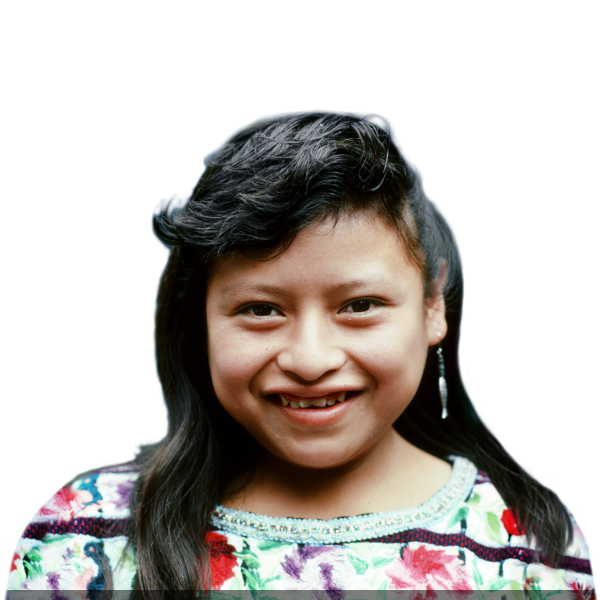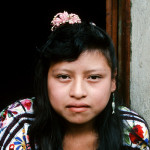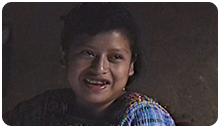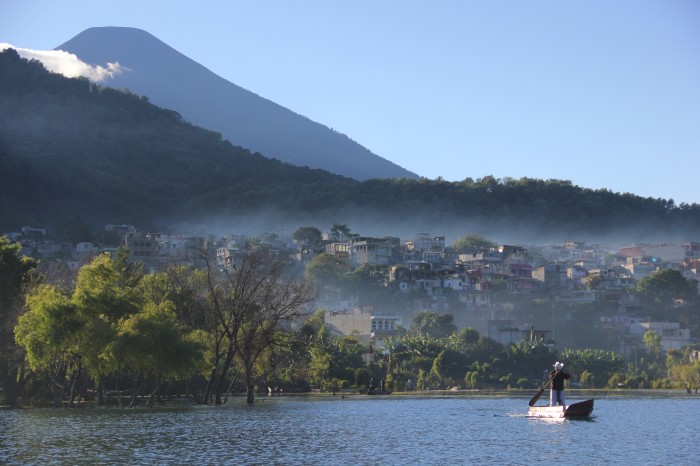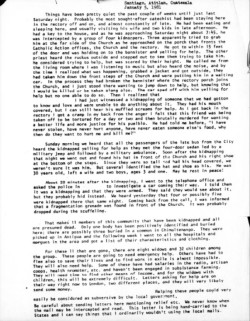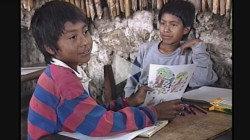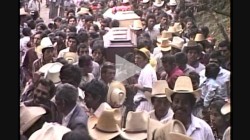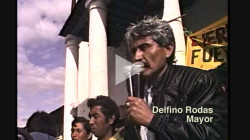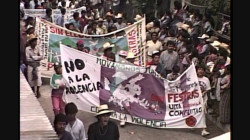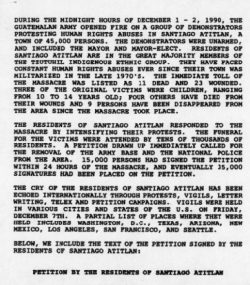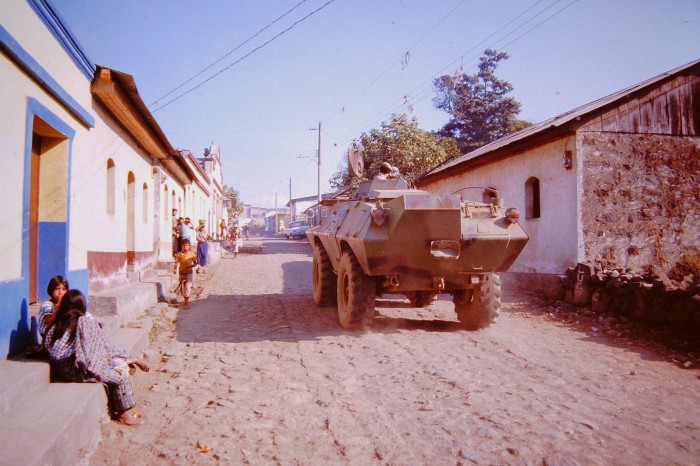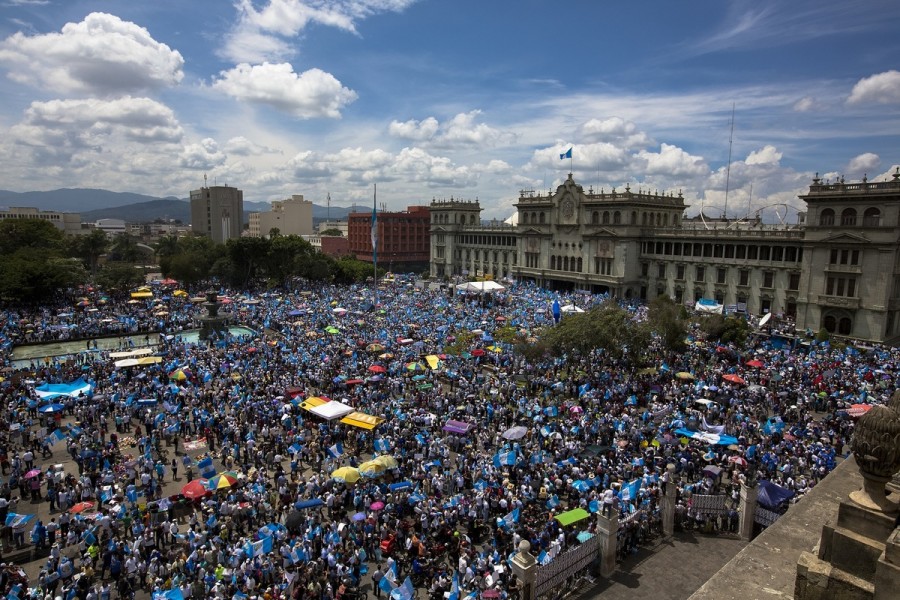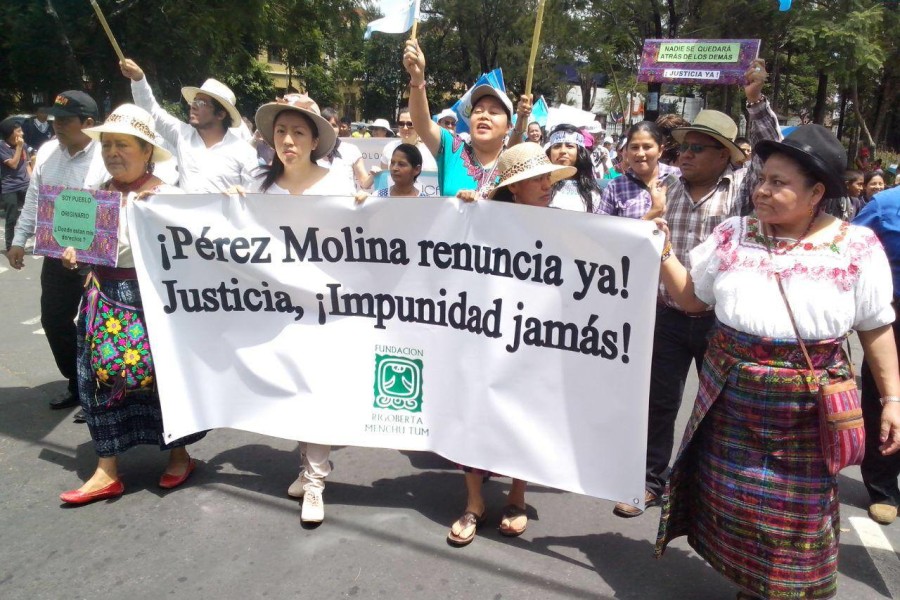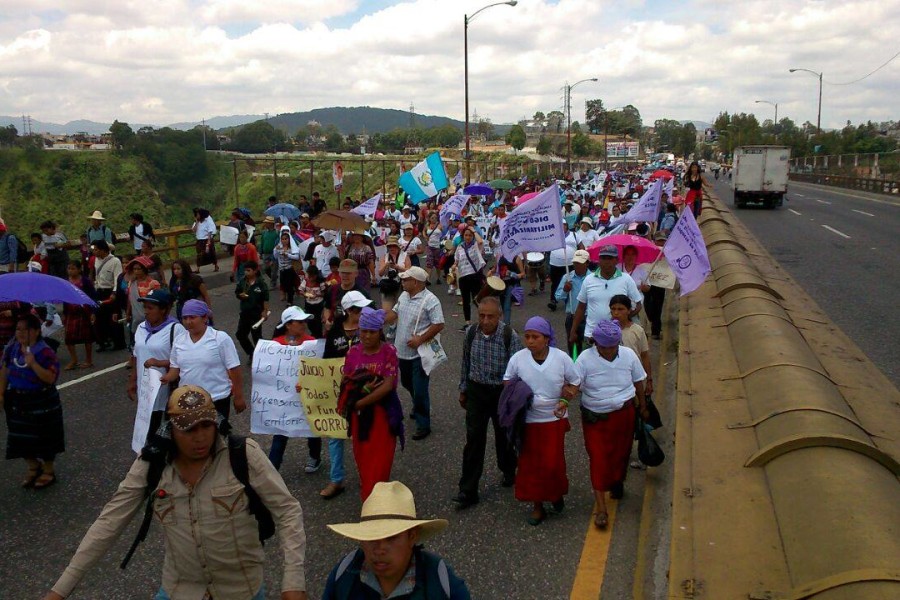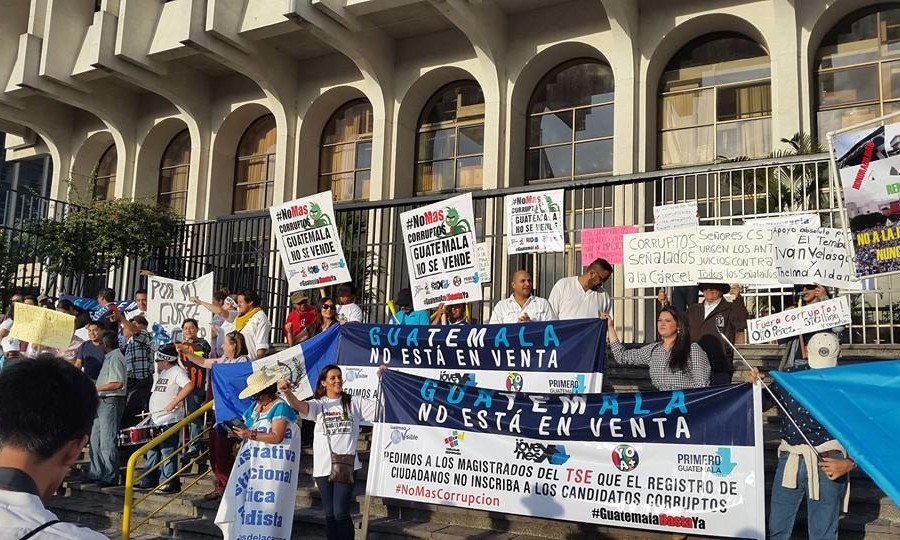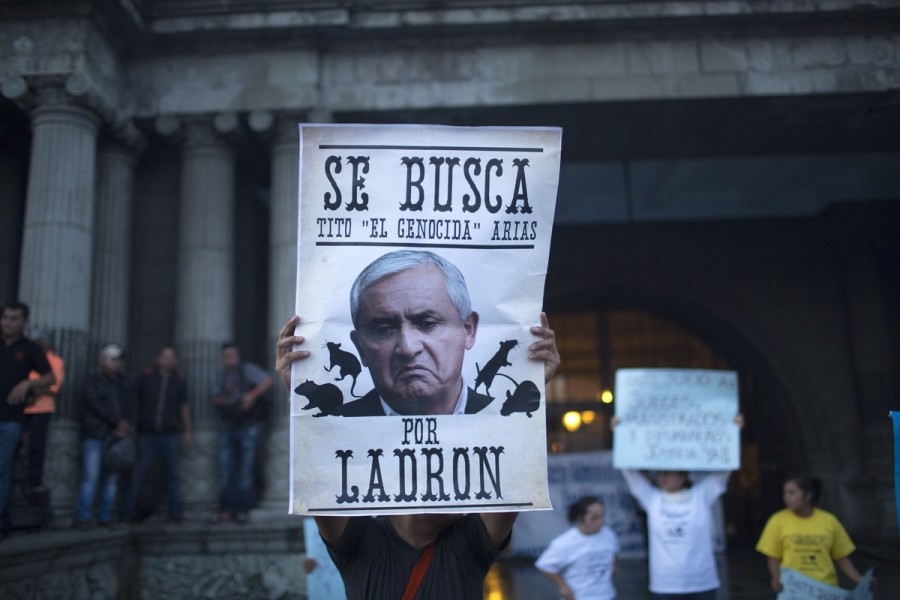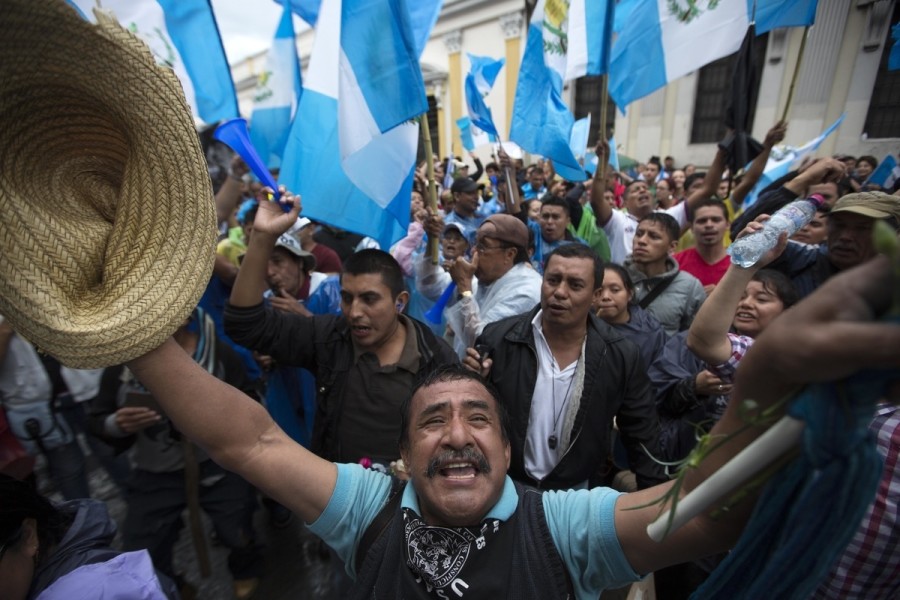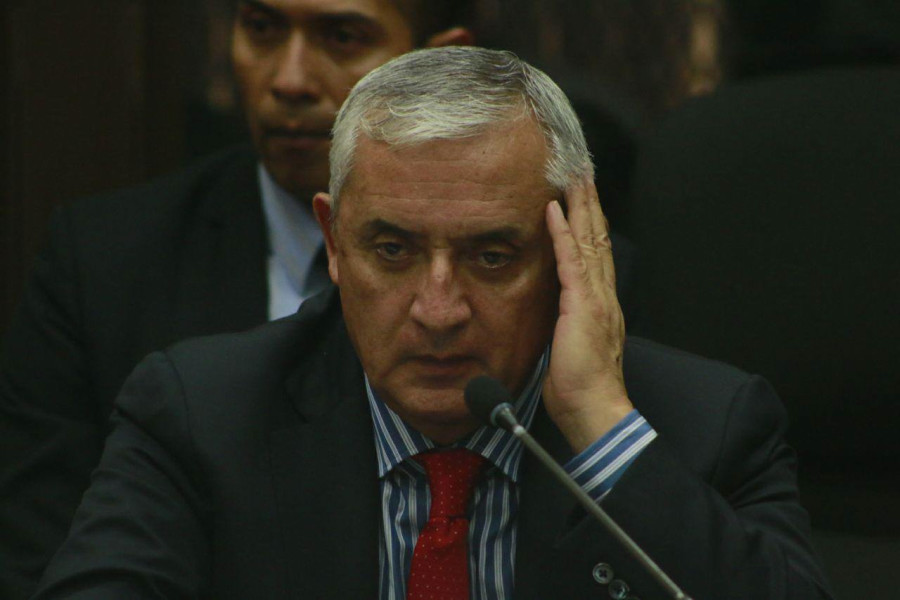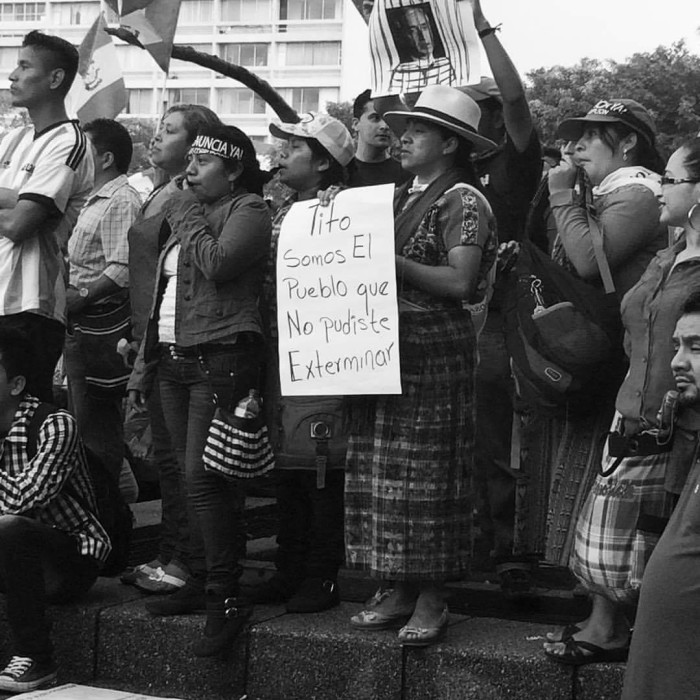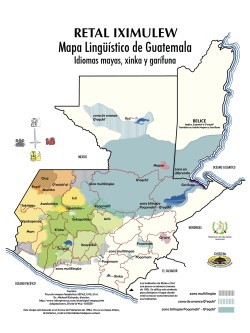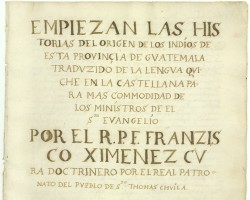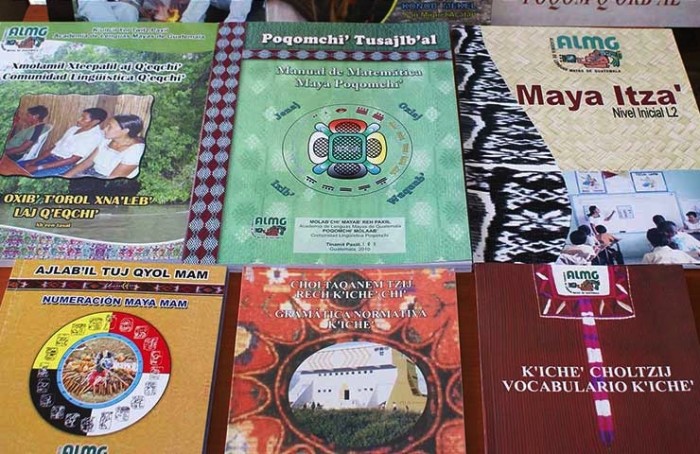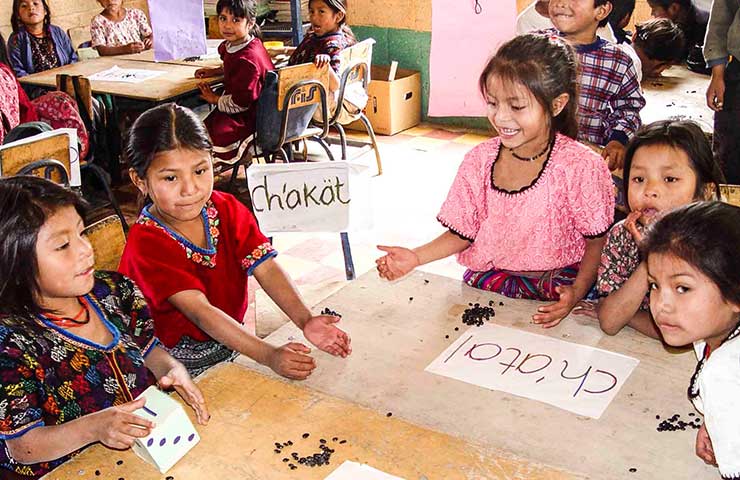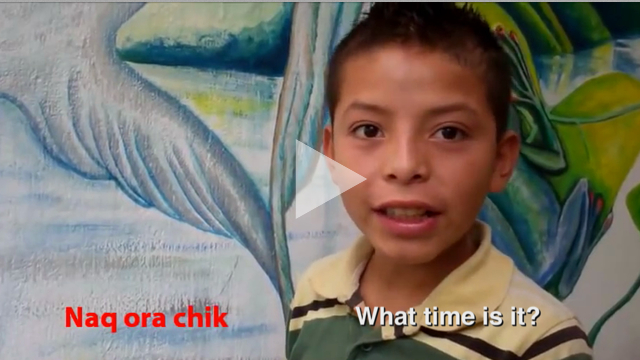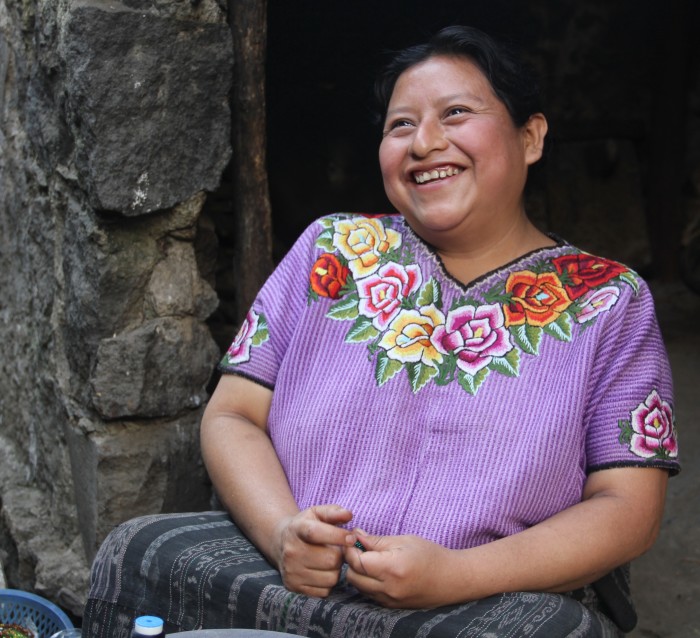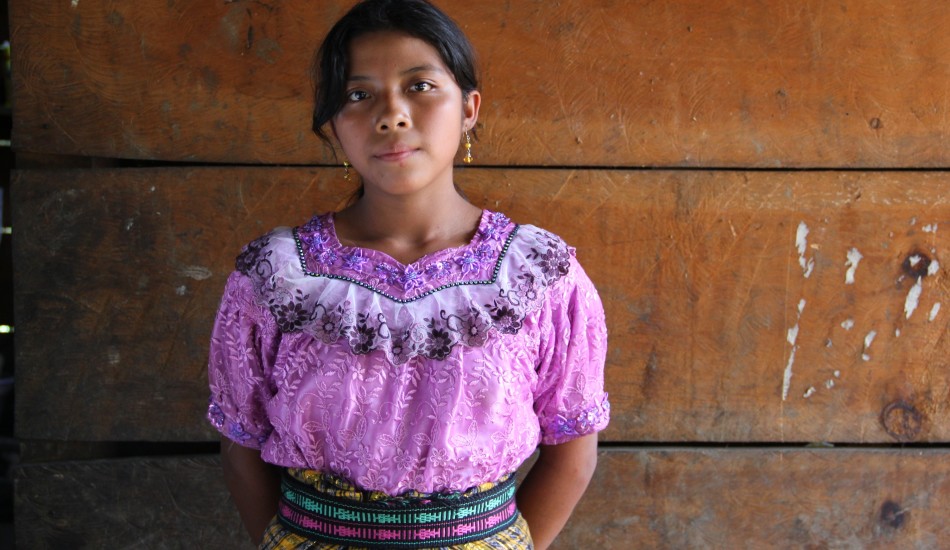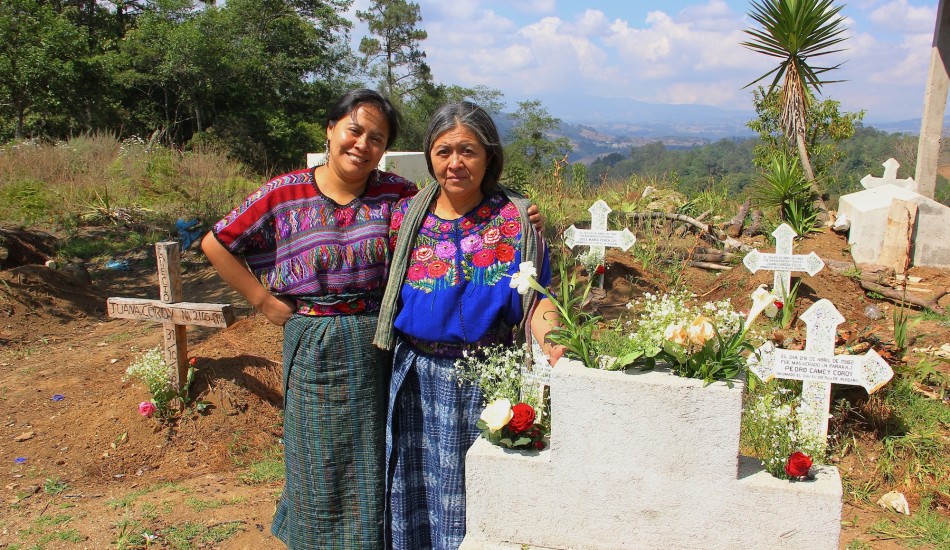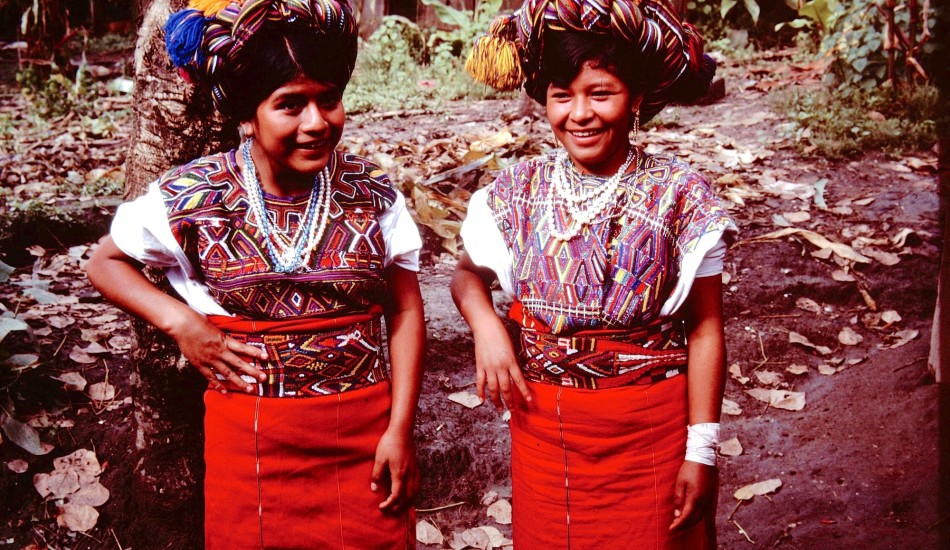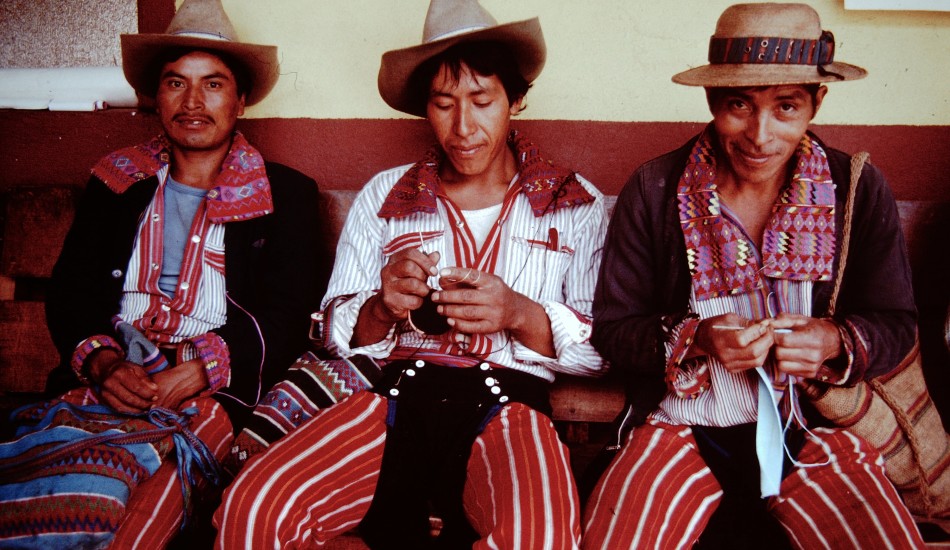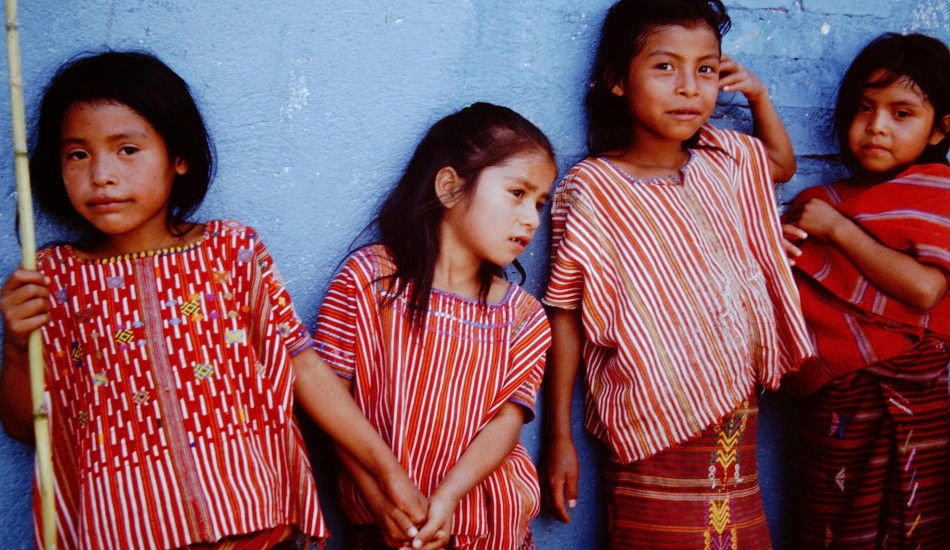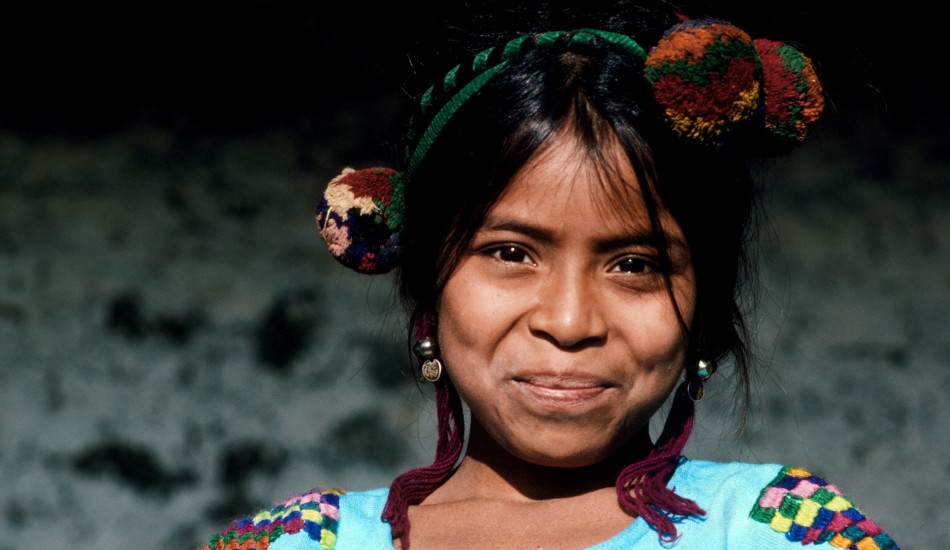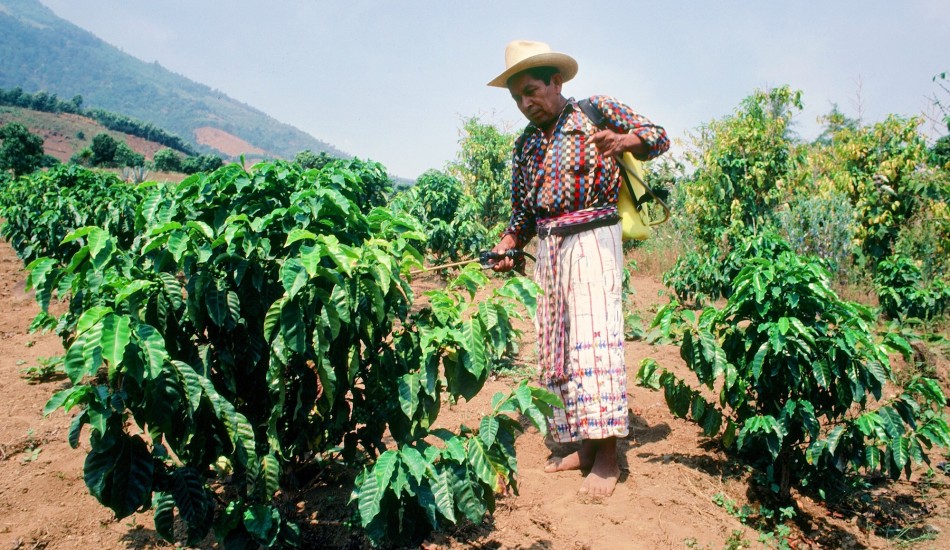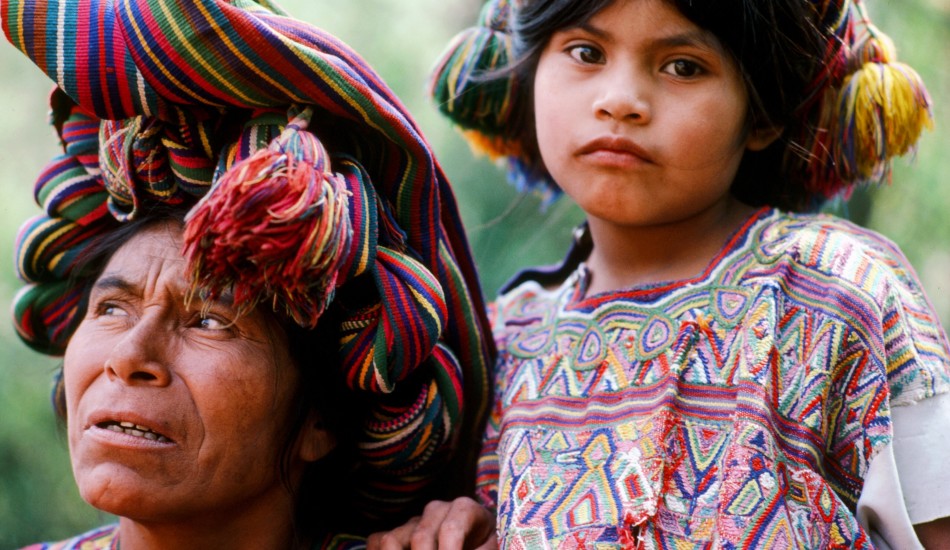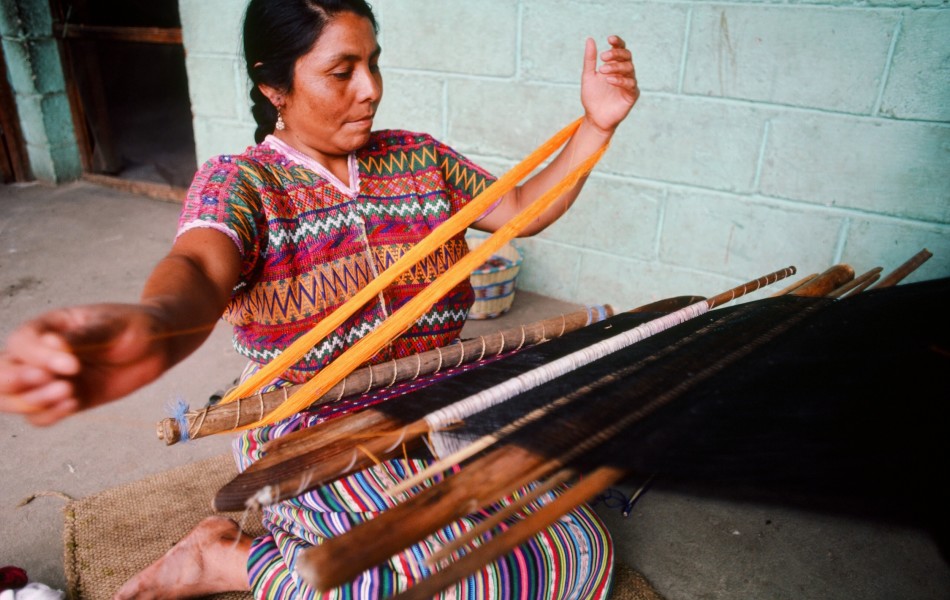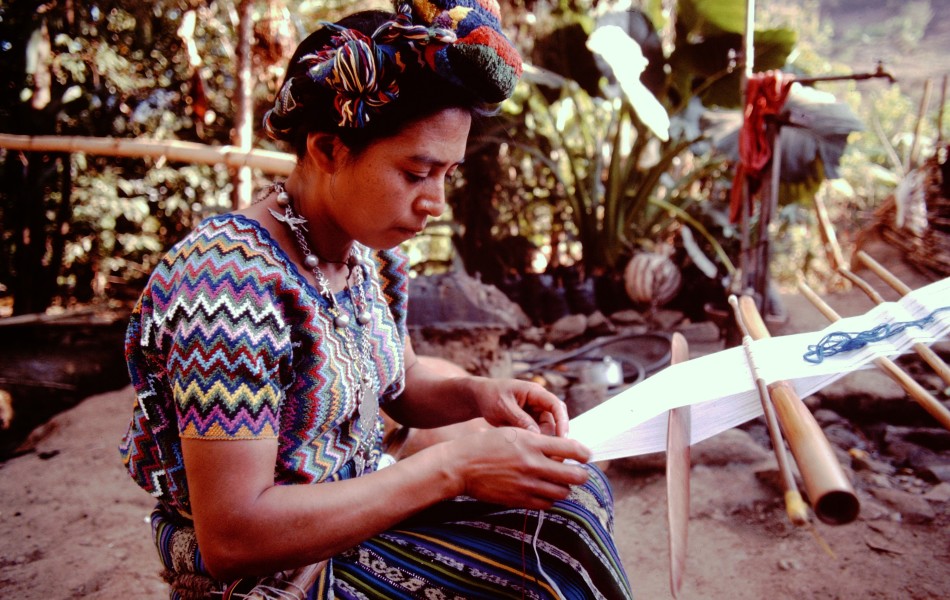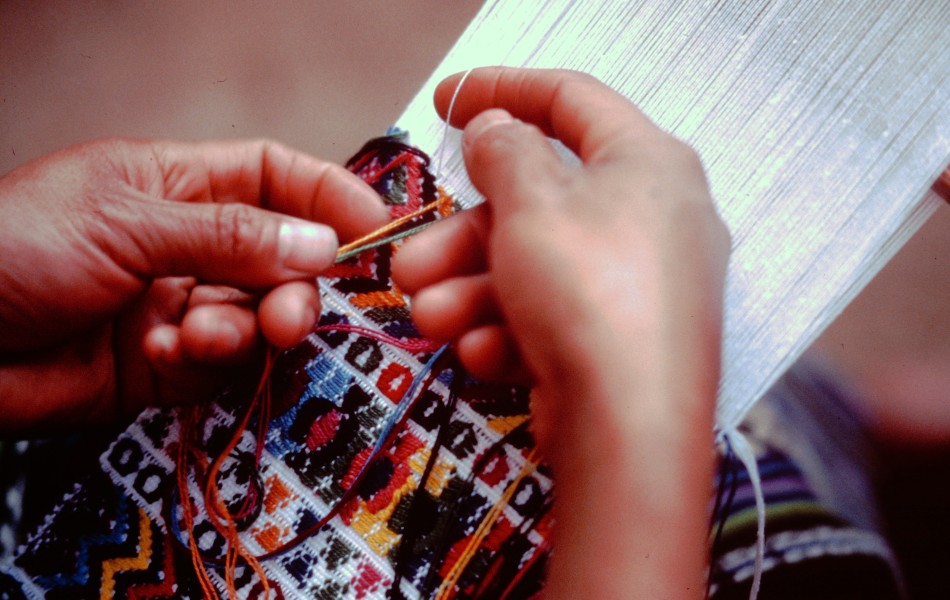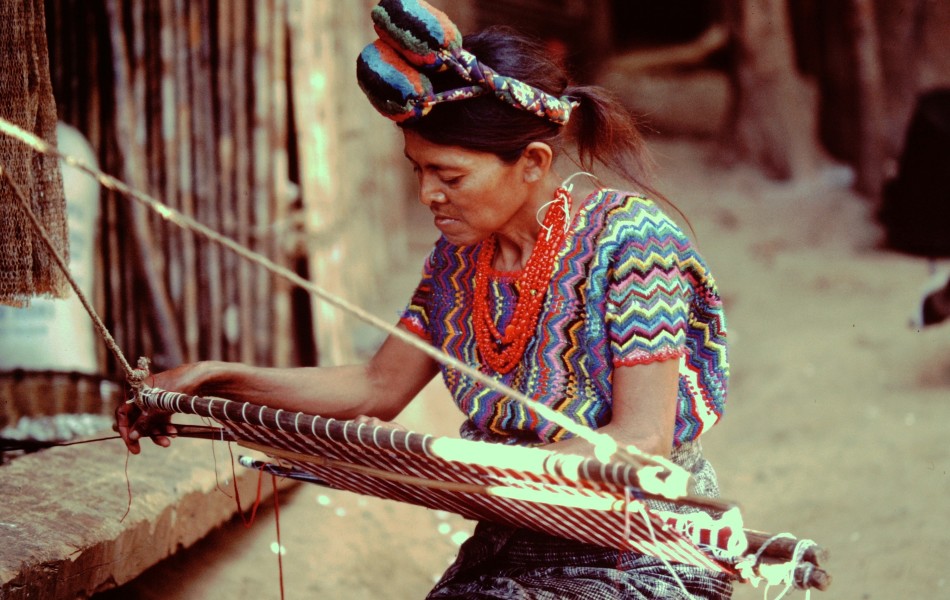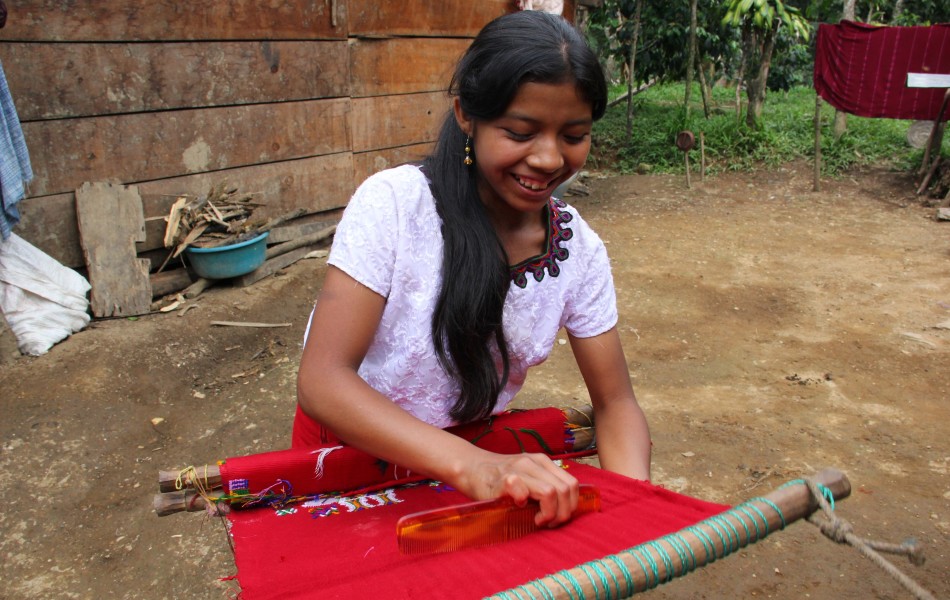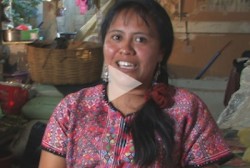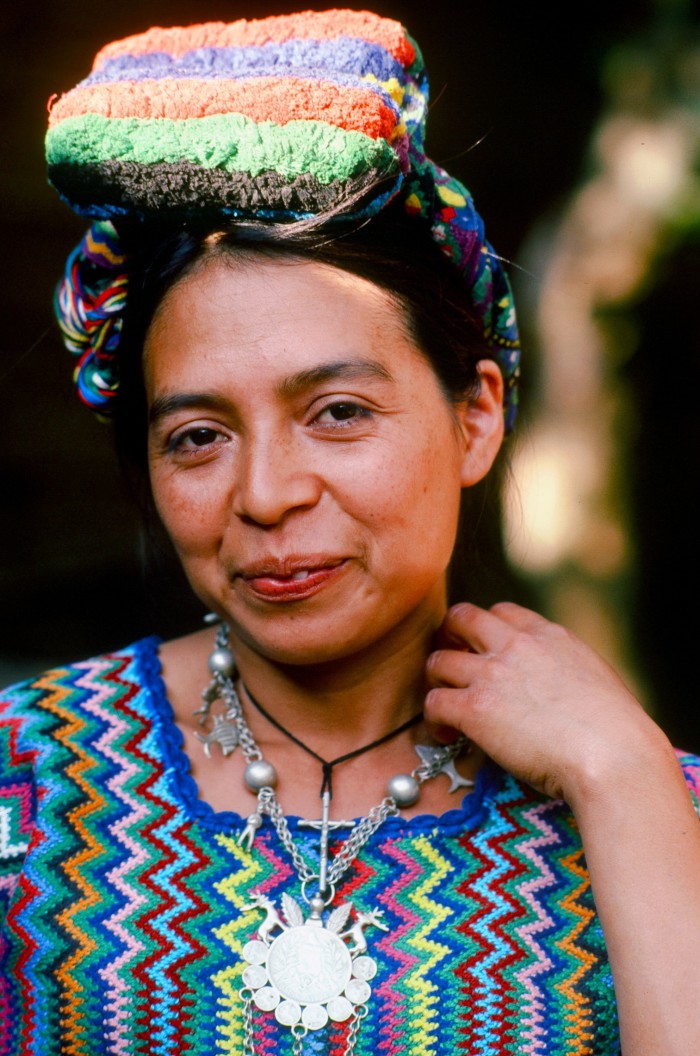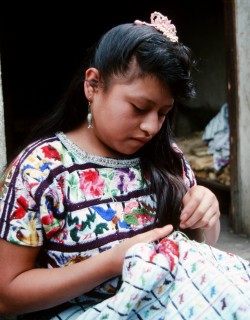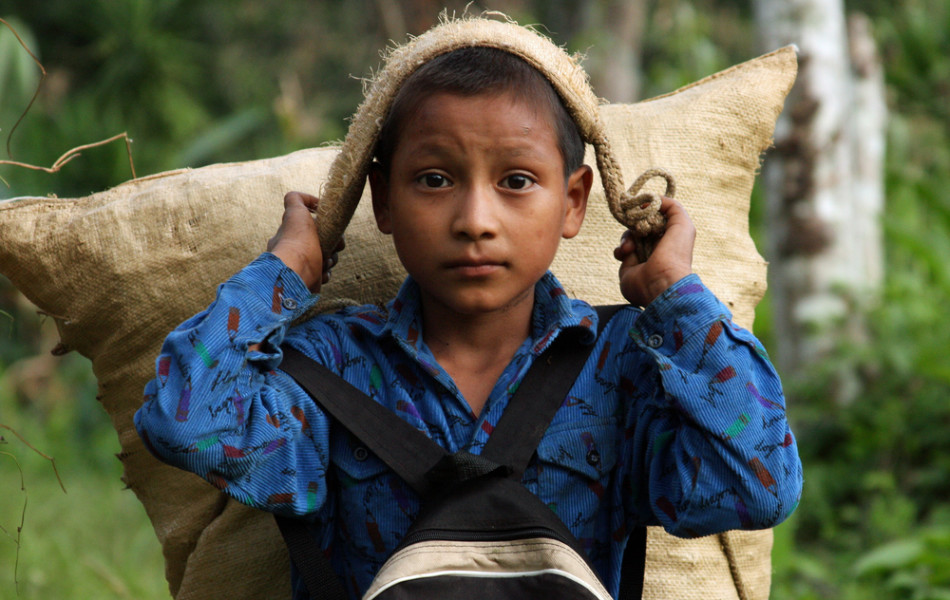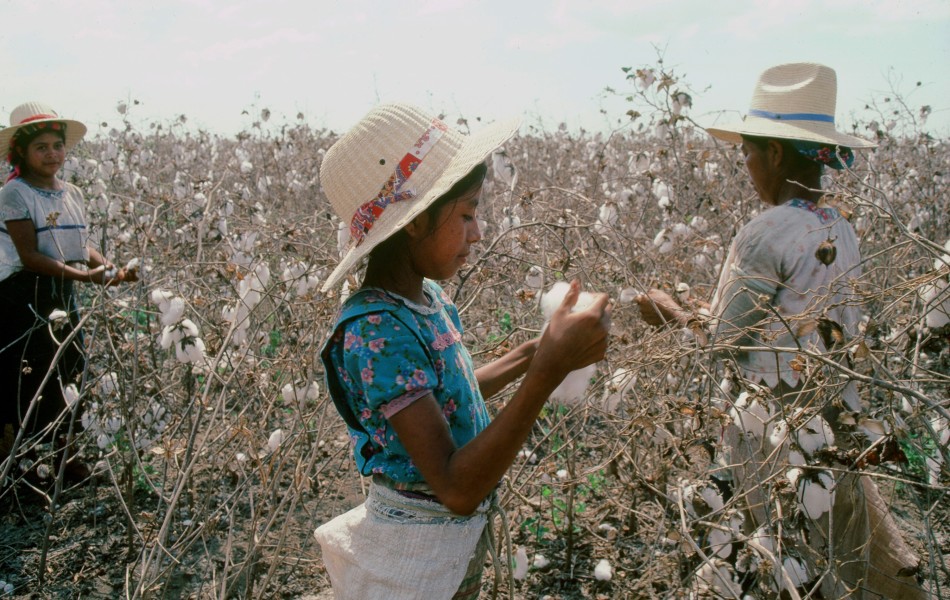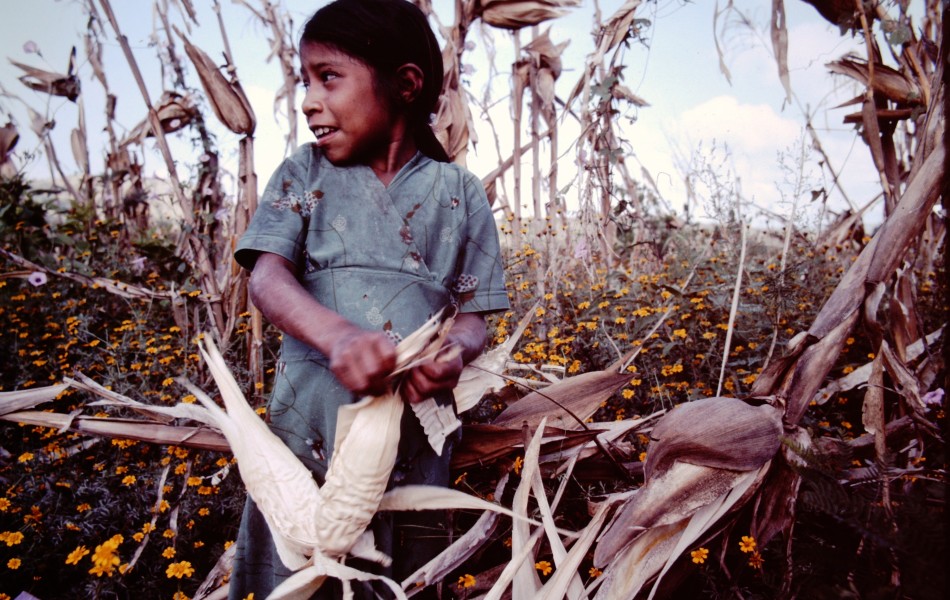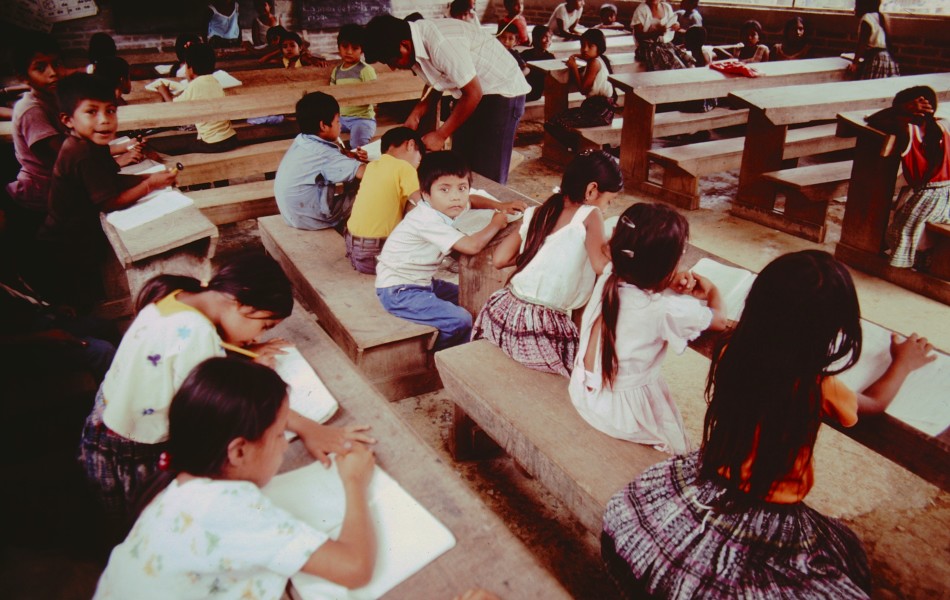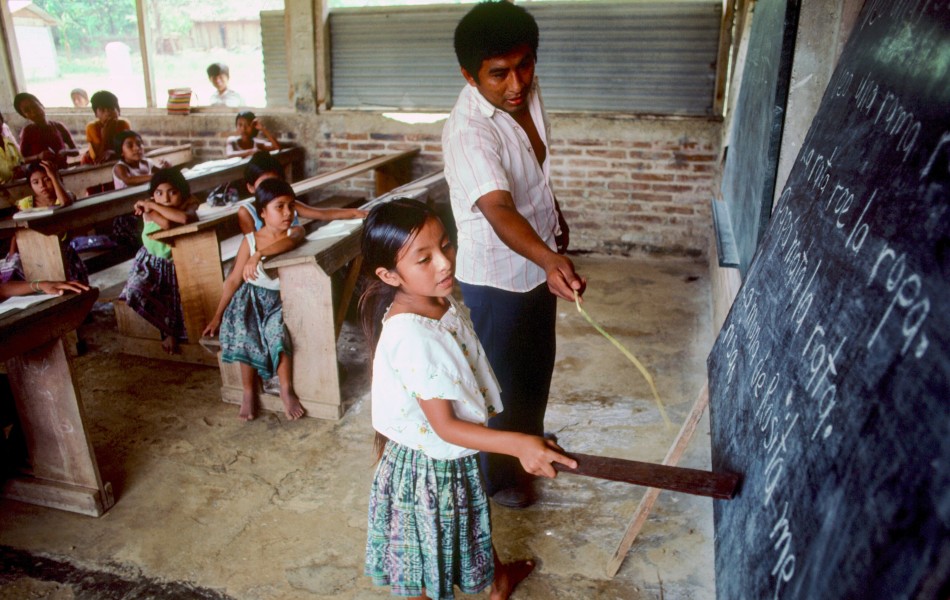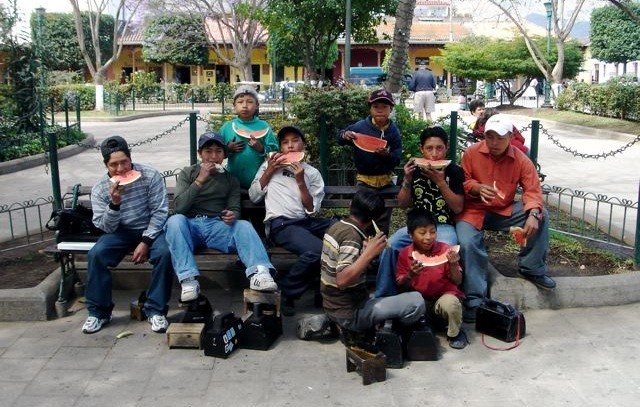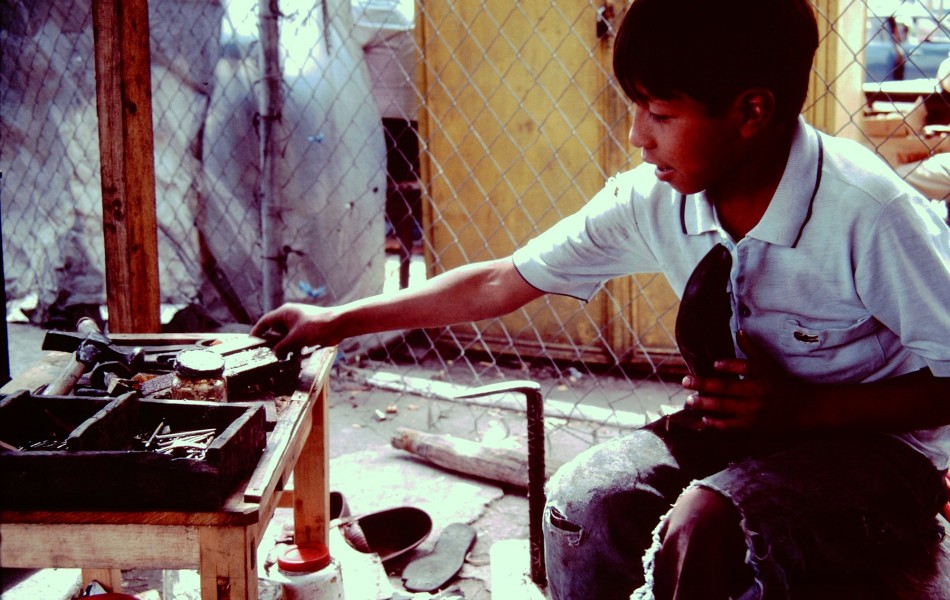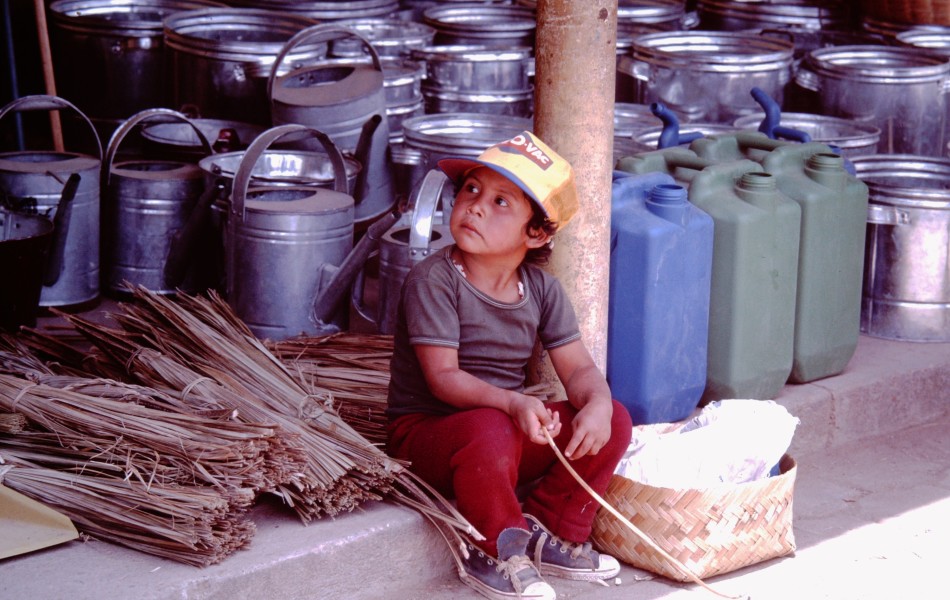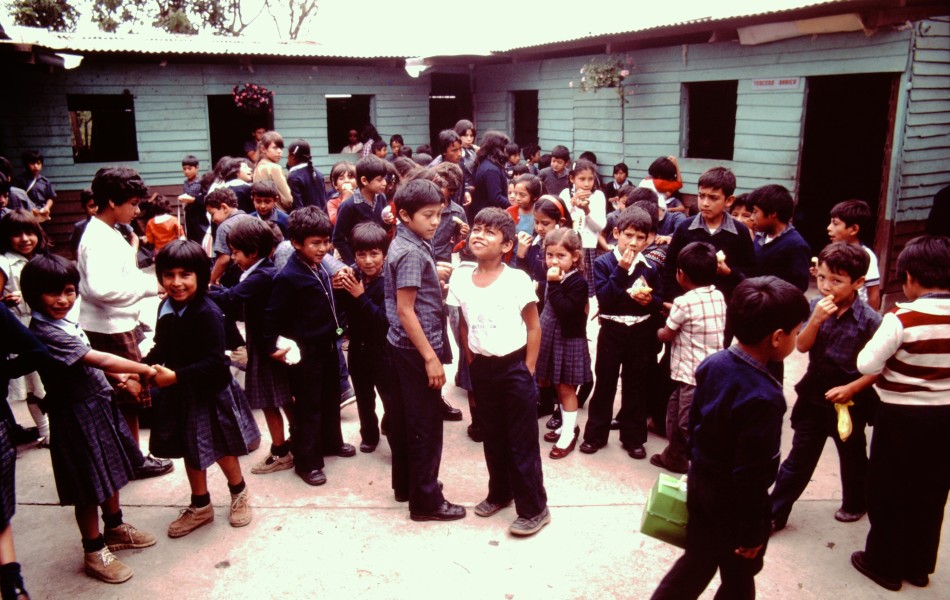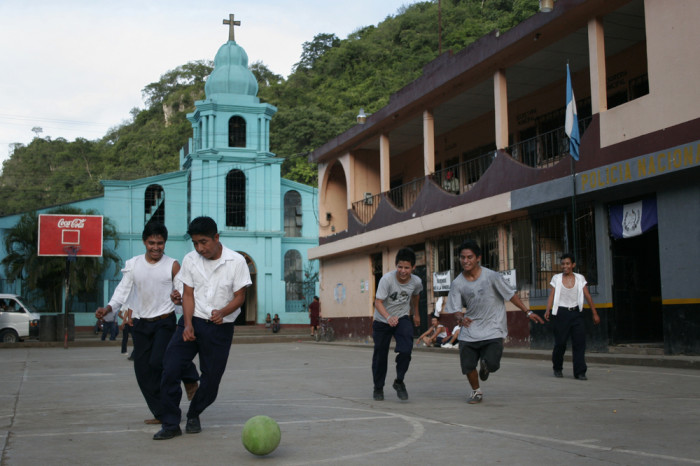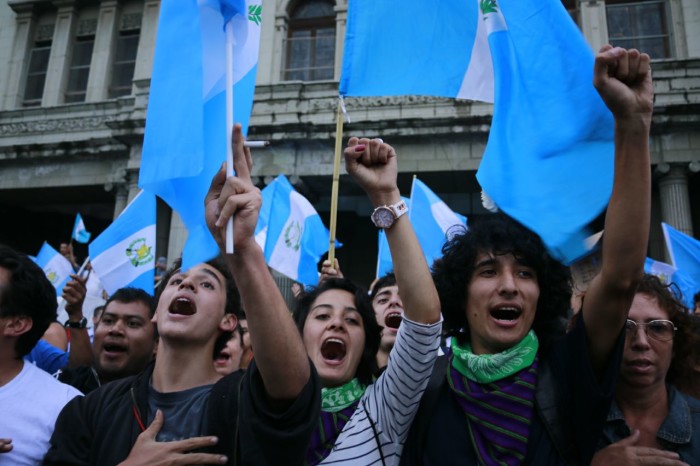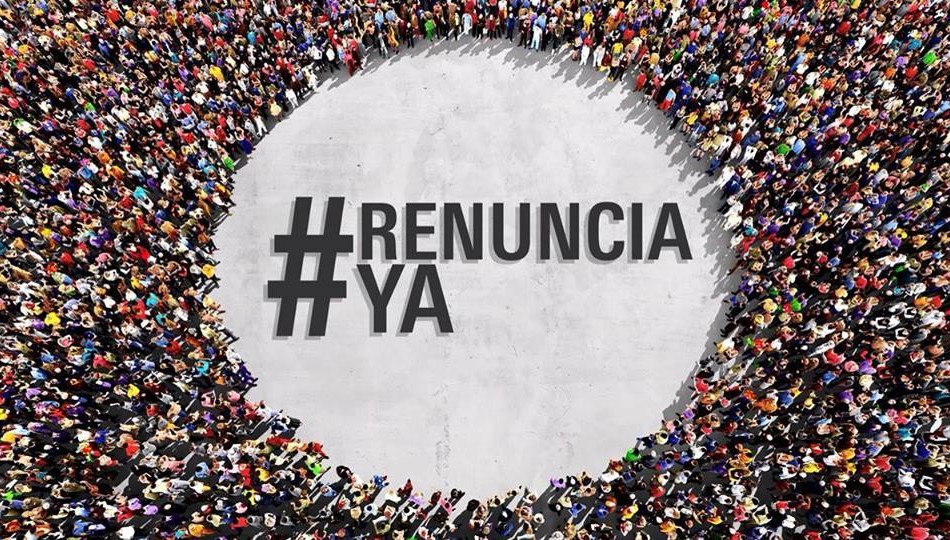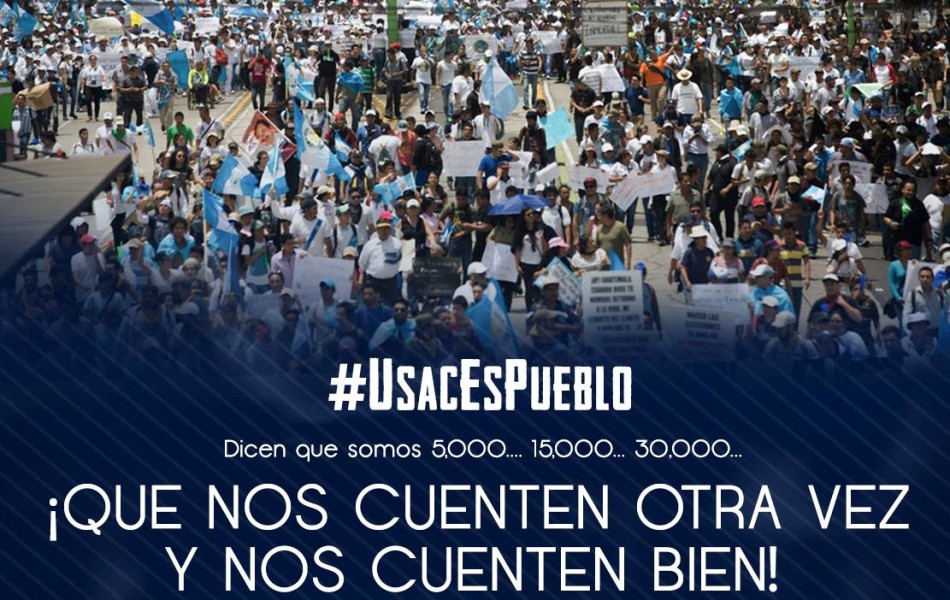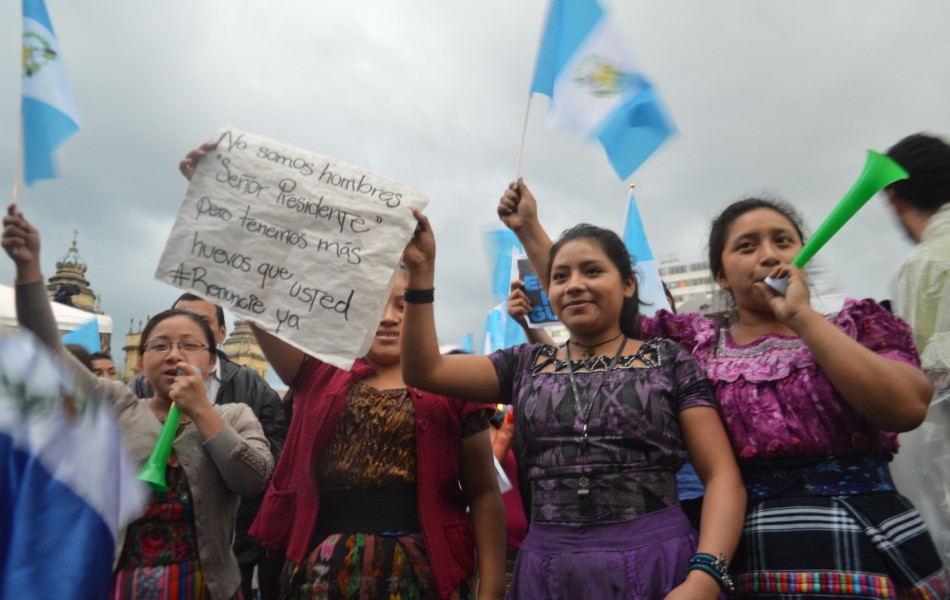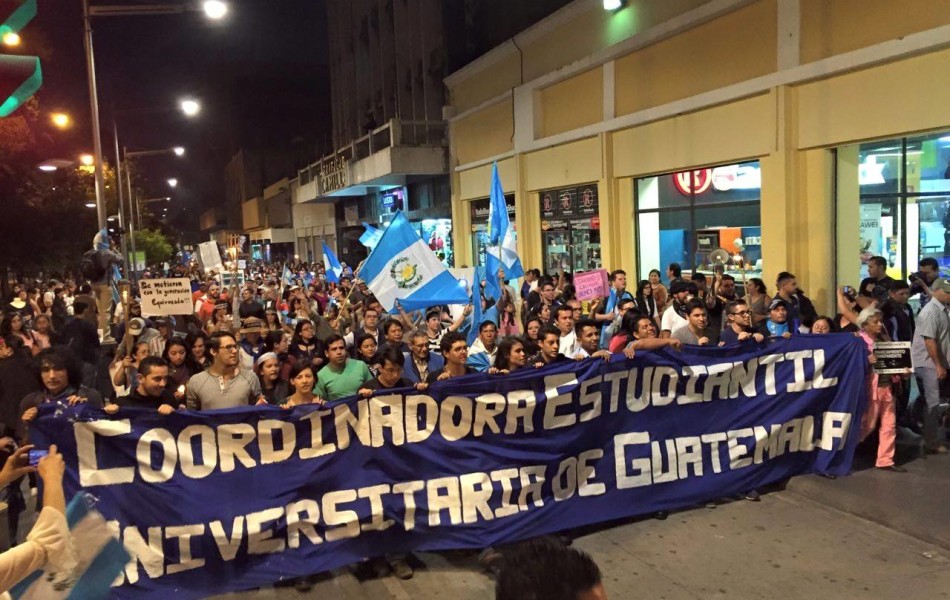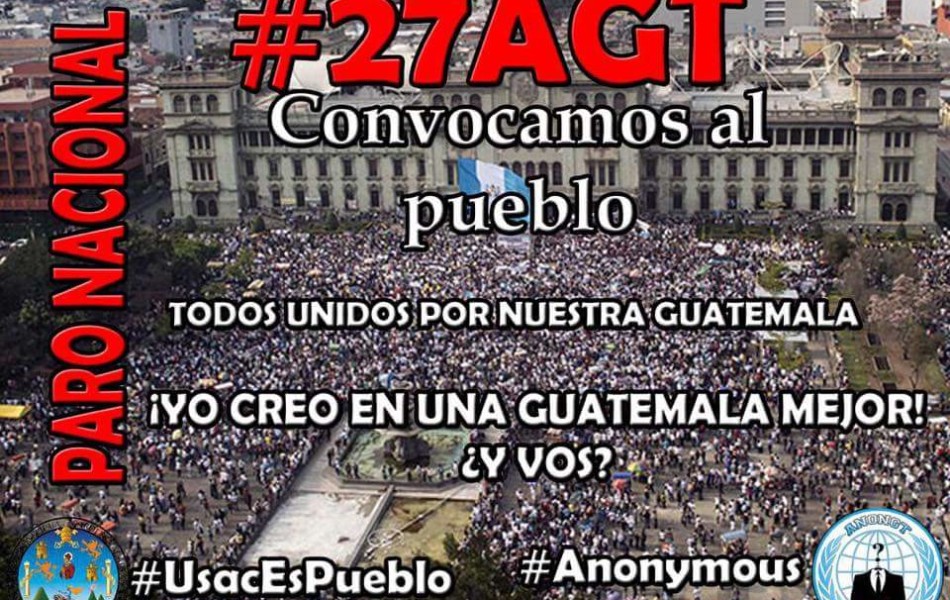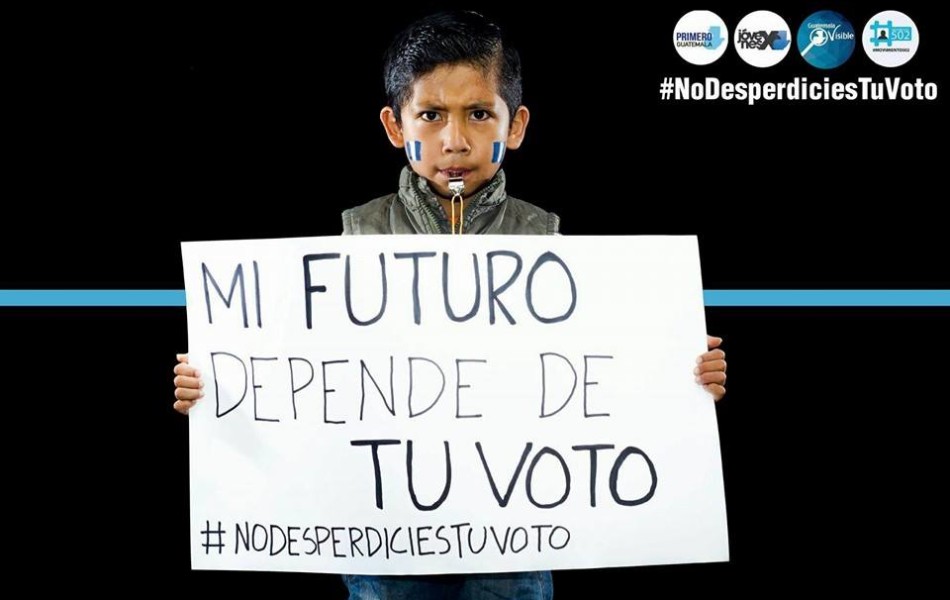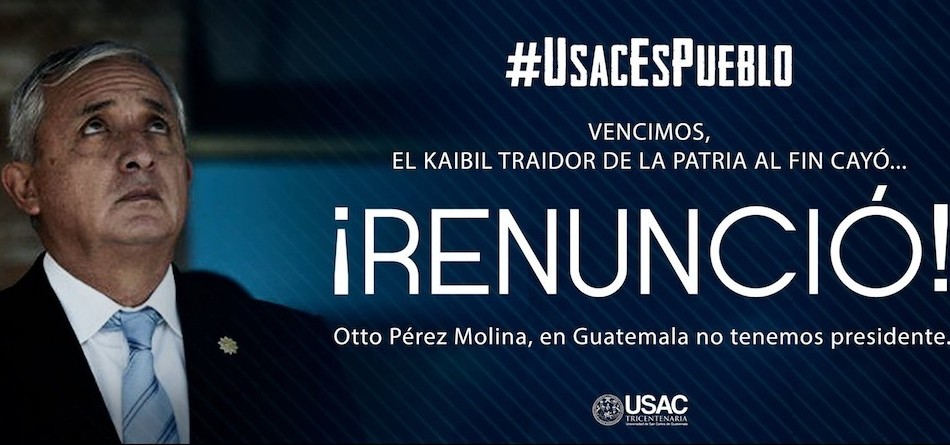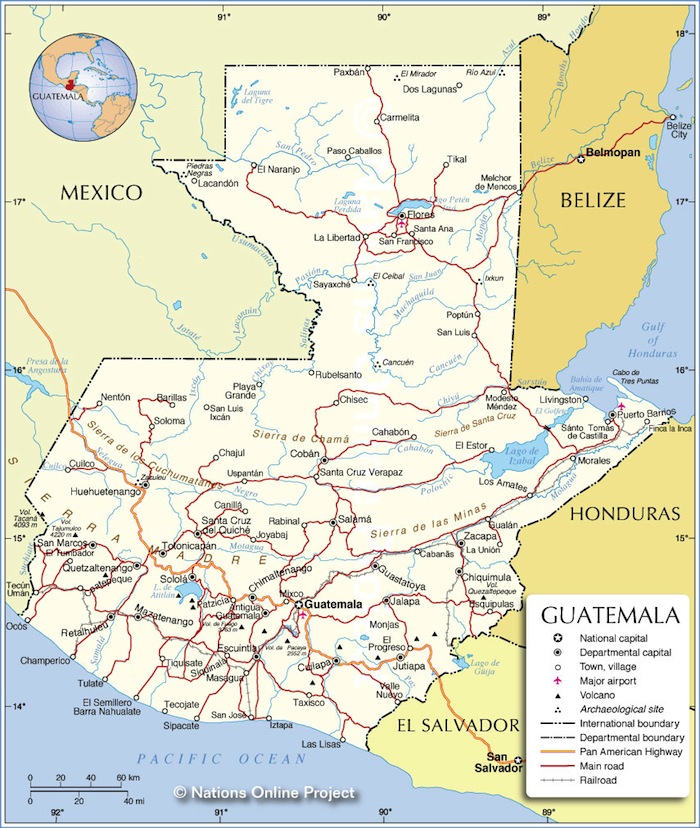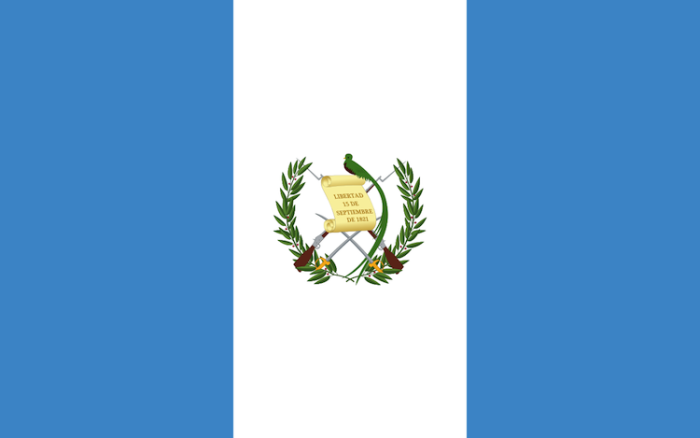BEFORE & AFTER THE MASSACRE
Santiago Atitlán is renowned for its beauty, perched alongside a lake ringed by volcanoes. But it also holds a unique place in Guatemalan history. On the edge of town, a Peace Park commemorates the site of the massacre where Rosario’s brother and 12 others were killed in 1990, setting in motion a popular protest that resulted in a rare victory over Guatemala’s repressive military regime. To understand the significance of these events, it’s helpful to look at the previous decade.
In 1980, during the civil war, a guerrilla organization was active in the region and openly recruited Atitecos (as those from Santiago Atitlán are called). In response, the army began an occupation of the town and sought to cease civilian support for the guerrillas. The army spread fear and terror as they kidnapped, murdered, disappeared and raped many Atitecos, especially targeting teachers, Catholic lay workers, peasant organizers and the community radio station. As Rosario recounts, dead bodies turned up frequently and pervasive fear and distrust settled in like thick fog over the town. Atitecos stopped venturing outside of town to work their land or collect fuel wood, afraid they might be captured. Women were scared to travel to markets in neighboring towns. House-to-house searches were common. In 1981, Father Stan Rother, the resident Catholic priest, was murdered. Originally from Oklahoma, he had been in Santiago Atitlán for 13 years.
Americas Watch, a human rights organization, estimates that at least 800 Atitecos were killed or disappeared between 1980 and 1990, the vast majority by the army. Even though the guerrilla’s local activities had vastly diminished since their peak in 1982 and had effectively stopped by 1988, the army continued to target civilians. A close-knit community of about 25,000, just about every Atiteco knew someone, or was related to someone, who had been kidnapped or murdered. For even the youngest children, army killings were a routine fact of life.
How were the Atitecos, a majority Maya population, able to stop this cycle of violence? After the massacre in 1990, community response was immediate. Almost the entire town showed up to accompany the dead on the long funeral march from the church to the cemetery.
Then the Atitecos organized. At a huge gathering, the Mayor rallied his townspeople to stand up to the army.
Town officials implored both the army and the guerrillas to abstain from operating in the town. Student, trade union and peasant organizations from other parts of the country sent delegations to march in solidarity with the Atitecos.
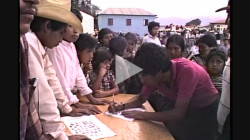
Clip of Atitecos marching and signing the petition demanding the army leave Santiago Atitlán. December 1990.
Atitecos circulated a petition demanding the immediate removal of the army base, a thorough investigation of the massacre, and justice for those responsible. They sent this petition to President Vinicio Cerezo, with the signatures and thumbprints of thousands of people.
The government’s own Human Rights Attorney quickly issued a report blaming the army as an institution, naming three soldiers directly involved, and calling for shutting down the army base. During the many years of civil war, the army had rarely been held officially accountable for its violence against the civilian population. The Catholic Church called the massacre an act of genocide and recommended compensation to the families of the victims. The Guatemalan Congress unanimously passed a resolution calling for the army to leave and for those responsible to be punished. Just a few weeks later on December 20, 1990, the army withdrew its 600 soldiers. For the first time ever in Guatemala, a town had expelled the army. This victory had international repercussions. Both the US and German governments suspended military aid, citing the massacre in Santiago Atitlán as one of many ongoing serious human rights violations.
A year after the massacre a military tribunal convicted a sergeant major to sixteen years in prison for the dead and wounded. They found a second soldier guilty of public intimidation and sentenced him to four years. However, eyewitnesses suggested it was not possible for all of the dead and wounded to have been shot by only one soldier. Many in the human rights community were disappointed that the government chose to blame individual soldiers rather than the Army as an institution with its long history of abuse toward the Atitecos. Nonetheless, it was one of the first times in Guatemalan history that military personnel were sentenced to prison for committing human rights violations.
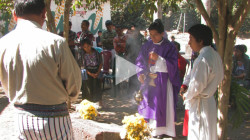
Clip of Rosario and her family celebrating mass on the anniversary of the massacre. December 2, 2011.
Every year on the anniversary of the massacre, Atitecos still gather at the Peace Park to celebrate mass in commemoration of those who died.
SOURCES & LINKS
Americas Watch. “Guatemala, Getting Away with Murder: An Americas Watch and Physicians for Human Rights Report.” August 1991.
Carlsen, Robert. “After the Bloodshed: Reexamining the Peace in Santiago Atitlán.” Report on Guatemala, Vol. 15 Issue 1, Spring 1994.
http://arks.princeton.edu/ark:/88435/sb397934h
––––––. The War for the Heart & Soul of a Highland Maya Town. Austin, TX: University of Texas Press, 2011 (revised edition).
Cockrell, Cathy. “Popular Pressure Forces Army Out of Santiago.” Report on Guatemala, Vol. 11, Issue 4, Spring 1991.
http://arks.princeton.edu/ark:/88435/1r66j2071
Loucky, James and Carlsen, Robert. “Massacre in Santiago Atitlán: A turning point in the Maya Struggle?” Cultural Survival Quarterly, Fall 1991.
http://www.culturalsurvival.org/publications/cultural-survival-quarterly/guatemala/massacre-santiago-atitlan-turning-point-maya-stru
Perera, Victor. Unfinished Conquest: The Guatemalan Tragedy. Berkeley, CA: University of California Press, 1993.
Report of the Guatemalan Human Rights Attorney (Procurador de Derechos Humanos), December 7, 1990.
http://arks.princeton.edu/ark:/88435/0v838150m
Rother, Stanley. “Cry From Guatemala.” The New York Times, August 15, 1981.
http://www.nytimes.com/1981/08/15/opinion/cry-guatemala-following-are-excerpts-letter-written-jan-5-7-1981-rev-stanley.html
THE LEGACY OF VIOLENCE
Rosario mentions a brief period of peace following the army’s expulsion from Santiago Atitlán, before the threats and incidents and fear returned. The legacy of the repression perpetrated by the state on the people of Guatemala is deep and complex. An entire generation of Guatemalans came of age in an environment of extreme violence. The army in Santiago Atitlán – as well as everywhere else – sowed distrust within communities. They encouraged local people to turn on one another, using bribes and threats. They selected men to supervise the civil patrols, called military commissioners, whose corruption and abuse was widely known, resulting in everything from petty theft to rape and murder. All of this destabilized communities and created a culture of violence in Guatemalan society that many argue still resonates today.
Two decades after the war ended, Guatemala suffers from one the highest rates of violent crime in Latin America. There’s an abundance of weapons – some left from the war but many imported since then – but few jobs. Today, young men comprise the majority of both the perpetrators and victims of violence. A Catholic Church report accuses the economic system of “manufacturing poor people” and suggests that if society provided the economic conditions to allow young people, in particular, to satisfy their basic needs, perhaps they would not feel compelled to commit crimes. And impunity reigns, trickling down from the mastermind of war time atrocities to the lowly pickpocket.
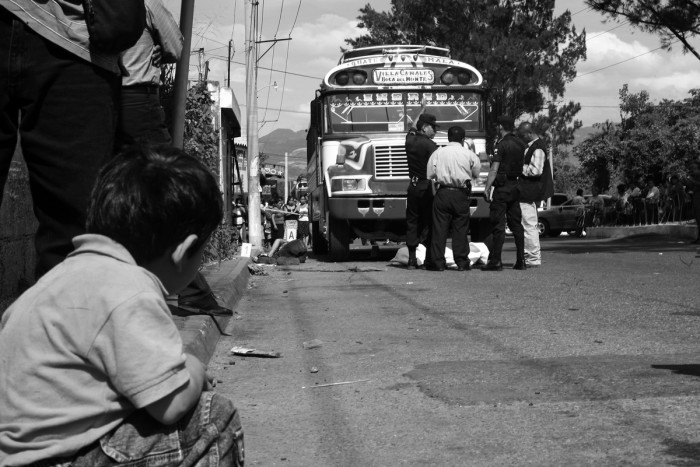
A young boy observes the dead body of his father, a bus driver, killed by unidentified gunmen on the outskirts of Guatemala City. Photo by Saul Martinez.
Most reports highlight gang and drug related crime, but there are also other forms of violence plaguing Guatemala today. Targeted killings against specific groups of people such as human rights workers, or peasant activists opposing mines or dams are not uncommon, though far below war time levels. There have been lynchings and “social cleansing” crimes, where self-appointed vigilantes and citizens take it upon themselves to hand out “punishment” to those they deem guilty or undesirable. In Guatemala City, there have been waves of femicide against working class women. Most notorious are the systematic killings of urban bus drivers by thieves and extortionists (who are sometimes gang members) demanding payments. These acts have terrorized entire communities.
Gangs have been growing in size in Guatemala steadily since the mid-1980s. While some originally allied themselves with the struggle of the poor, they became steeped in an environment of violence and death, against each other, the poor, and everyone else. A major influence in the 1990s came from the gang culture brought back to the region from deported Guatemalans who had been Los Angeles gang members. Their families had fled the Central American violence in the 1980s and sought refuge in the US. (Many were from El Salvador and some of them found their way to Guatemala as well.) After deportation, they found the poor neighborhoods in Guatemala City to be fertile territory for new recruits who had few hopes of studying or working their way into a better life.
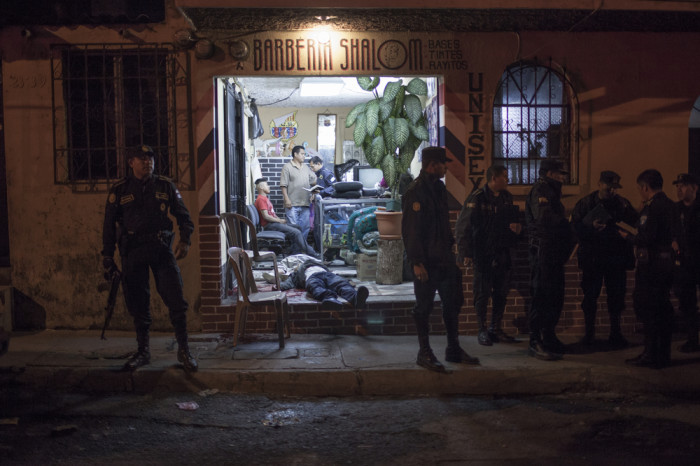
Police guard a crime scene where two unidentified men in their early twenties were gunned down while waiting to get a haircut. Guatemala City. July 12, 2014. Photo by James Rodríguez/MiMundo.org.
Drug trafficking is considered the largest single factor behind the violent crime rates in Guatemala, which is situated right in a major corridor between the drug producers (South America) and the consumers (US). Drug runners and other criminals operate openly, as they are rarely apprehended. A United Nations Special Rapporteur commented in 2009 that Guatemala is “a good place to commit murder” because 98% of crimes went unpunished and the murder rate was one of the highest in the hemisphere. He concluded that the primary obstacle to combating crime was a lack of political will to fund and implement a justice system that could end impunity.
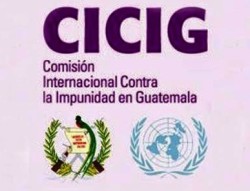
International Commission Against Impunity in Guatemala
A major development in the fight against crime in Guatemala came in 2007 with the creation of a United Nations backed judicial watchdog called CICIG (International Commission Against Impunity in Guatemala). Its mandate is to help the Guatemalan judicial system identify, dismantle and prosecute clandestine criminal networks. Most of these networks evolved from the repressive intelligence and paramilitary structures focused on counter-insurgency activities during the civil war. Although the war formally ended in a negotiated settlement (known as the 1996 Peace Accords) between the army and the guerrillas, the army retained its power. The repressive structures were not dismantled; instead, they transformed into new criminal networks dedicated to organized crime and corruption.
Over the years, CICIG has proven that investigators with proper training and resources can go after even the most well-entrenched government officials, criminals and networks. In the spring of 2015, CICIG and the Guatemalan Public Prosecutor’s Office exposed a massive corruption scheme involving reduction of customs taxes in exchange for kickbacks to government officials, reaching all the way to the President.
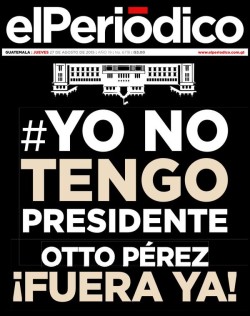
Front page of el Periódico, August 27, 2015.
Guatemalans took to the streets and began weekly protests in front of the National Palace in Guatemala City, as well as in other cities, calling for the corrupt officials to resign and be placed on trial. Tens of thousands of people routinely participated, organized largely through social media. On August 27, there was a nationwide strike with major roads blocked around the country. Over 100,000 people showed up to register their discontent in Guatemala City. Smaller numbers gathered in the provincial capitals. The entire front page of that day’s edition of el Periódico featured the National Palace upside down with a key slogan of the movement: “#I Don’t Have A President” and “Otto Pérez – Out Now!”
It’s hard to overstate the outrage and indignation felt by ordinary Guatemalans who suffer the consequences daily of the millions and millions of dollars stolen by their corrupt officials, past and present. As one columnist, Dina Fernández, wrote in el Periódico: “Guatemala finally lost its patience. The society had kept its mouth shut and put up with too much for too long. Now, after thirty years of continual abuses, it demands that its officials respond as they are supposed to: in favor of the interests of the population, and not at the service of a clique of thieves and contrabandists operating out of the Presidential Residence.”
The protestors’ efforts paid off: in early September, 2015, then-President Otto Pérez Molina – a former military intelligence officer implicated in genocide and other high profile human rights abuses – was forced to resign. He was escorted to jail, following in the footsteps of his former Vice-President and several dozen other former officials who were already behind bars. A poster held by a Maya woman in traje proclaimed: “Tito – We are the people that you could not exterminate.” (“Tito” was an alias of Pérez Molina when he was a military official.) Another protestor’s sign captured the sweep of history in just a few words: “They took everything from us, even our fear.”
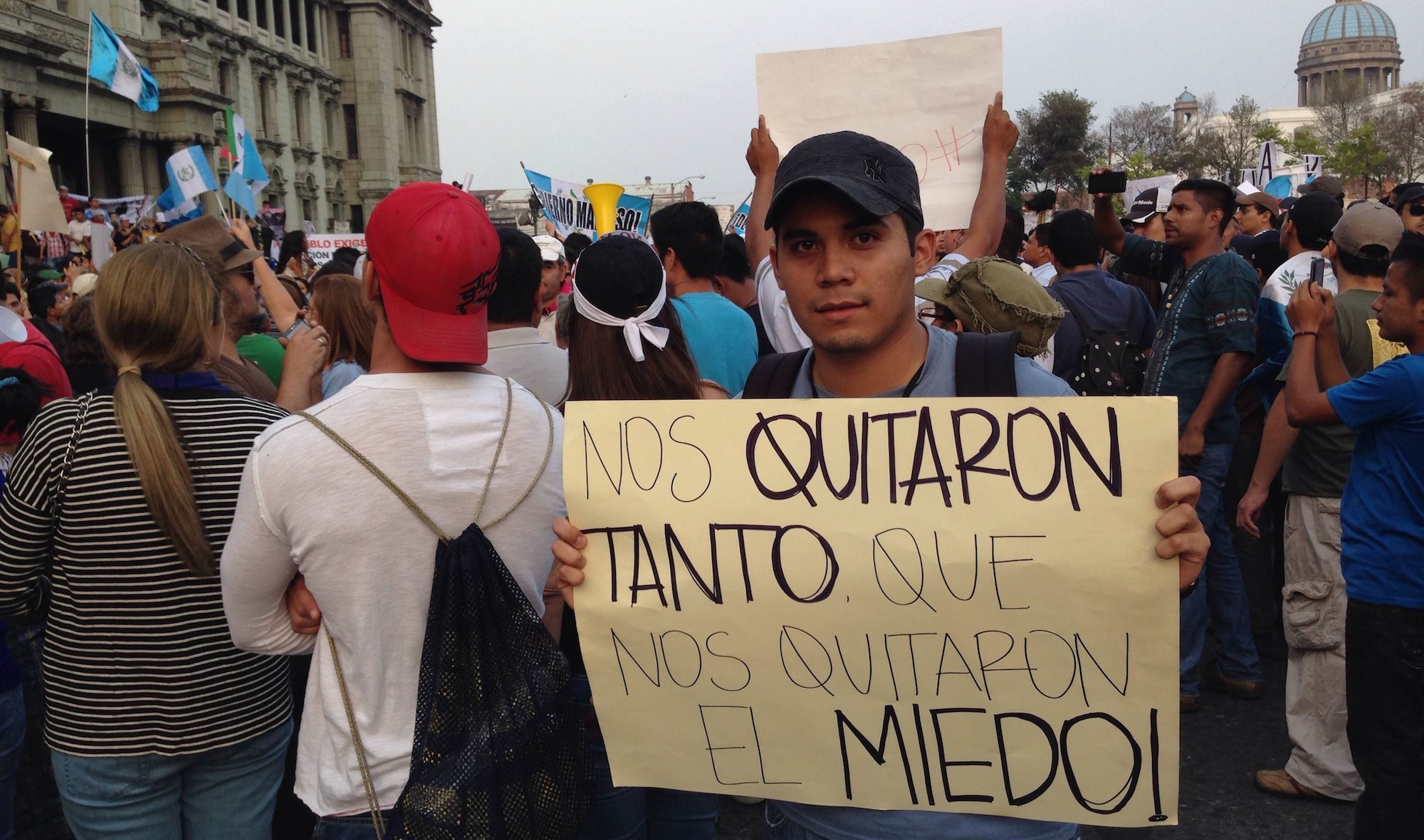
“They took everything from us, even our fear.” Guatemala City. Photo courtesy of Carlos Sebastián.
SOURCES & LINKS
Aizenman, N. C. “Self-Styled Justice in Guatemala.” The Washington Post, February 24, 2006.
http://www.washingtonpost.com/wp-dyn/content/article/2006/02/23/AR2006022302285.html
Goldman, Francisco. “From President to Prison: Otto Pérez Molina and A Day for Hope in Guatemala.” The New Yorker, September 4, 2015.
http://www.newyorker.com/news/news-desk/from-president-to-prison-otto-perez-molina-and-a-day-for-hope-in-guatemala
International Commission Against Impunity in Guatemala (CICIG)
http://www.cicig.org/index.php?page=home
Levenson, Deborah T. “What Happened to the Revolution?” in Carlota McAllister and Diane M. Nelson, eds. War By Other Means: Aftermath of Post-Genocide Guatemala. Durham and London: Duke University Press, 2013.
Moloney, Anastasia. “Court ruling attacks Guatemala for failure to tackle crimes against women.” Thomas Reuters Foundation, July 31, 2014.
http://www.trust.org/item/?map=guatemalas-femicides-show-no-signs-of-letting-up/
Nómada. “En la marcha más grande de su historia, Guatemala grita: #NoTengoPresidente.” August 20, 2015.
https://nomada.gt/en-la-marcha-mas-grande-de-su-historia-guatemala-grita-notengopresidente/
Open Society Justice Initiative. “Guatemalan Genocide Trial Scheduled to Reopen This Week Amid Growing Corruption Crisis.” International Justice Monitor, July 20, 2015.
http://www.ijmonitor.org/2015/07/guatemalan-genocide-trial-scheduled-to-reopen-this-week-amid-growing-corruption-crisis/
Partlow, Joshua. “How a peaceful political uprising happened in war-scarred Guatemala.” The Washington Post, September 5, 2015.
https://www.washingtonpost.com/world/the_americas/how-a-peaceful-political-uprising-happened-in-war-scarred-guatemala/2015/09/05/88664b34-5195-11e5-b225-90edbd49f362_story.html?postshare=5991441726489338
Smythe, Frank. “The Untouchable Narco-State: Guatemala’s Army Defies DEA.” The Texas Observer, November 18, 2005.
http://www.franksmyth.com/the-texas-observer/the-untouchable-narco-state-guatemalas-army-defies-dea/
US Department of State. “Guatemala 2014 Human Rights Report.”
http://www.state.gov/documents/organization/236904.pdf
Washington Office on Latin Amercia (WOLA). “Report on the International Commission against Impunity in Guatemala (CICIG).” March 2015.
http://www.wola.org/sites/default/files/CICIG%203.25.pdf
WHAT LANGUAGE IS ROSARIO SPEAKING?
Rosario speaks a Mayan language called Tz’utujil (pronounced “su-to-heel”), which is also the name of her ethnic group. It is spoken by about 80 – 90,000 people. It is one of the 22 Mayan languages spoken in Guatemala today by approximately 6 million people total. (Spanish is the official language.) Mayan languages today can differ a little or a lot, but have similar historical roots.
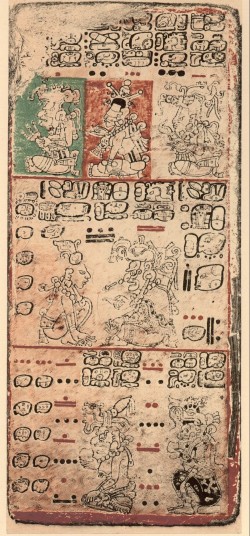
Page from the Dresden Codex. This is the oldest book written in the Americas, dating from the 11th or 12th century. It is one of only 15 books that survived the Spanish Conquest.
The ancient Maya developed the hemisphere’s first written language which flourished between about AD200 and 1200. Their hieroglyphic writing produced a collection of literature, but very little survived the Spanish conquest which sought to destroy their beliefs and culture. Mayas who learned to read and write in the 16th century (using a Spanish-based alphabet) produced such classic texts as the “Popul Vuh,” the creation story of the Maya, and “Annals of the Cakchiquels,” which recounts the legends of the Kaqchikel nation. After that, literacy declined until the relatively recent efforts began to record and preserve the written and oral Mayan languages.
The 1996 Peace Accords defined Guatemala as a multiethnic, multicultural and multilingual nation. (The Accords were signed by the government and the guerrillas and brought a formal end to the 36 year long civil war.) Part of the Accords committed the government to recognize, respect and promote the Mayan languages, specifically in both the social welfare and judicial systems. They stipulated that social services at the community level should be delivered in the local language; that interpreters be made available in the courts; and that members of indigenous communities should be informed in their own languages about their rights and obligations. Even twenty years after the Accords, the challenge remains to put much of what was agreed upon in theory into practice.
The government also committed to expanding and promoting bilingual education. Efforts to bring bilingual education to Maya students actually began years before the Peace Accords in a pilot project that ran from 1979 – 1984. The following year bilingual education became a program within the Ministry of Education. The initial idea was to provide a transition from the child’s native language to Spanish, but in recent years the objective has also been to preserve and strengthen the Mayan languages as well. Doing so validates those languages for the students and their families. While school materials have been produced in Mayan languages and some teachers have received training, the actual percentage of students receiving even basic bilingual education has remained low and the overall quality is generally considered poor.
Like parents all over the world, Maya families vary in what they value most for their children. Some are concerned about their children growing up and not really speaking, let alone reading and writing, their native language. Language is one of the most important traits that link the present Maya with their past and is considered a cornerstone of cultural identity. Others believe the only way their children will realistically succeed in life is if they are taught to speak, read and write the dominant language, Spanish, even if it’s at the expense of their native language. The ideal for many is to embrace both languages: children can learn to read and write in their native language as well as become fluent and literate in Spanish.
In spite of the challenges and limitations mentioned above, Mayas today are increasingly writing in and about their indigenous languages. Several governmental agencies and educational institutions are focused on the Mayan languages and their preservation, although they remain chronically understaffed and underfunded. The first institution to be directed entirely by Mayas was the Guatemalan Mayan Language Academy (ALMG – Academia de Lenguas Mayas de Guatemala). Their first major accomplishment was to establish a unified alphabet for the Mayan languages that the government adopted in 1987, following a long and heated debate about which of several orthographies would be selected. Determining a single convention for writing the Mayan languages was an important step toward promoting literacy.
SOURCES & LINKS
Christenson, Allen J. Popul Vuh: The Sacred Book of the Quiché Maya. 2007. Electronic version of original 2003 publication.
http://www.mesoweb.com/publications/Christenson/index.html
DeChicchis, Joseph. “Current trends in Mayan literacy.” Kwansei Gakuin University, Japan, n.d.
http://www.ksc.kwansei.ac.jp/~jed/MultilingMulticult/Guatemala/Current_trends_in_Mayan_literacy.pdf
England, Nora C. “Mayan efforts toward language preservation” in Endangered Languages: Language Loss and Community Response, ed. by Lenora A. Grenoble and Lindsay J. Whaley. New York: Cambridge University Press, 1998; pp. 99 – 116.
Guatemalan Mayan Language Academy (Academia de Lenguas Mayas de Guatemala – ALMG)
http://www.almg.org.gt/
Jiménez Sánchez, Ajb’ee Odilio. “Mayan Languages and the Mayan Movement in Guatemala.” Paper presented at the Latin American Studies Association, Chicago, IL, Sept 24-26, 1998.
http://tamilnation.co/selfdetermination/countrystudies/mayan.pdf
Nelson, Diane M. “The Reconstruction of Mayan Identity.” Report on Guatemala, Guatemala News and Information Bureau, Vol. 12, Issue 2; Summer 1991.
Peace Accords Matrix, Kroc Institute for International Peace Studies, University of Notre Dame.
https://peaceaccords.nd.edu/provision/education-reform-accord-firm-and-lasting-peace
MAYA CLOTHING
Like Rosario, most Maya women in Santiago Atitlán and many other parts of Guatemala still wear traditional clothing called traje típico, or just traje. In some regions men also continue to wear traje though much less so than women. Traditional Maya clothing has been worn since before the Spaniards arrived. It is known for its brilliant colors, intricate designs, and delicate handiwork.
The basic elements of daily dress for women include a corte (skirt), faja (belt) and huipil (blouse). The huipil is usually the most expensive article of clothing a Maya woman uses. It is typically decorated with colorful, complex designs and patterns as well as various weaving and embroidery techniques. Many designs represent the natural world including flowers, animals, birds, mountains, trees, the sun and moon. There are often geometric shapes. Some designs carry great symbolic value related to the cosmos or a person’s connection with their community. It can take a woman weaving a few hours daily on her backstrap loom several months to make one huipil.
Traditionally, a Maya woman’s huipil indicates where she’s from, as nearly every town or region has a unique design. The origin of these geographic variations is unclear. Some historians suggest Spanish colonizers instituted the wearing of distinctive colors and patterns for each town as a way to keep track of indigenous people. Others argue that the geographic isolation of communities gave rise to the distinguishing characteristics of the huipil, which helped strengthen the community and shield it from outside influences.
In any case, the use of traje is one the most striking representations of Maya culture. It has played a central role in maintaining Maya identity and world view. The huipil in particular has become a symbol of Maya pride and identity. Weaving as an activity is a way to teach young Maya the meaning and importance of cultural symbols and to pass values down from one generation to another.
Various factors are causing today’s Maya women to change how they dress. Some women consider dressing in western style clothing as more modern or prestigious, but it’s not necessarily an either/or decision. Dora, for example, wears both clothing styles –in part due to the discrimination that often accompanies being easily identified as Maya in Guatemalan society. There are numerous incidents of Maya women being denied entry into upscale bars or restaurants when wearing traje. Guatemala’s first female Maya legislator, Rosalina Tuyuc, was sometimes stopped by security guards as she tried to enter the Congress, where she served as vice-president from 1996-2000. And for Maya living in other countries, wearing traje immediately identifies them as “outsiders.”
For many poor Maya women, the choice of whether to use traje or not comes down to economics. They can no longer afford to purchase, or don’t have the time to make, a traditional huipil woven by hand on a backstrap loom. Instead, they use machine embroidered fabrics with a floral motif that are not associated with any particular village or that include much simplified designs. Or they might simply purchase used clothing coming from the United States that costs very little compared to the handmade clothing.
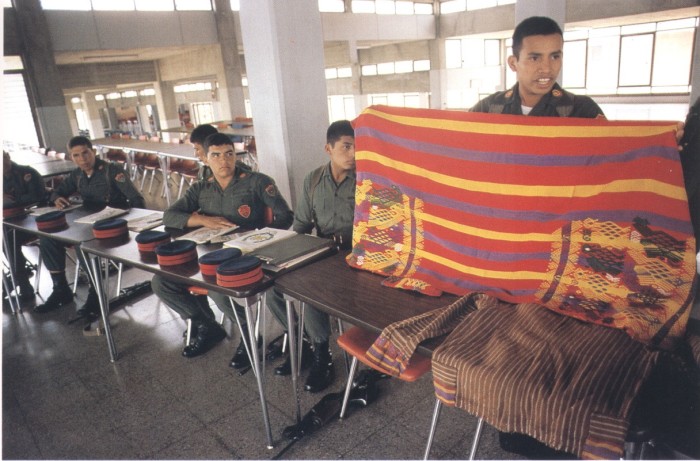
Cadet at the Politécnica Military Academy explains different huipil patterns. San Juan Sacatepéquez, 1982. Photo courtesy of Jean-Marie Simon.
The civil war impacted the wearing of traje. Many thousands of Maya women were displaced and some changed or stopped using their traje because they feared being identified with a conflictive area of the country (see Dora: “What Does It Mean To Be Displaced?”). Many women also changed their traje due to economic hardship or because they were unable to weave as they had in their community. Others refused to change, believing that wearing their traje during the civil war, in spite of the potential risk involved, was an act of cultural resistance.
Maya women who have migrated to urban areas also have had to give up using traje because their place of employment – whether they are a domestic or a factory worker – has uniform requirements that require western dress. More and more Maya women, especially those in the cities, who do use traje do not follow the tradition of wearing clothing associated with their place of origin. They might combine pieces from different areas or wear a complete outfit from another region, if they can afford it. Some do this to suit their particular taste; others see it as an expression of ethnic pride and pan-Maya identity and solidarity.
Irma Alicia Velásquez Nimatuj, a Maya-K’iche’ social anthropologist, notes that the “folkloric” images of Maya women in particular have been valued marketing tools for the tourist industry, even as real Maya endure both widespread discrimination and profound poverty. But for her, the act of wearing traje overtly challenges that racism and oppression. She views the use of traje as a political act asserting Maya identity, cultural resistance and self-determination. “Whenever we are seen in regional traje, the ruling classes are reminded of the failure of their efforts to make us disappear, which have ranged from genocide to ideological coercion. Five centuries of humiliation have not succeeded in bringing the Maya people to their knees.”
SOURCES & LINKS
Boj-Lopez, Flori. “Maya Youth and Cultural Sustainability in the United States” in Gabriel Gutiérrez, ed., Latinos and Latinas At Risk: Issues in Education, Health, Community, and Justice. Santa Barbara, CA: ABC-CLIO, LLC, 2015, pp. 164 -168.
Cojolya, Association of Maya Women Weavers
http://www.cojolya.org/
Martin, Jodi. “Contextualizing the Debate on Weaving Groups and Development: Mayan Weaving and the Changing Politics of Identity in Guatemala.” Totem: The University of Western Ontario Journal of Anthropology: Vol. 11: Issue 1, Article 9 (2003).
http://ir.lib.uwo.ca/totem/vol11/iss1/9
Museo Ixchel del Traje Indígena.
https://museoixchel.org/inicio/
Nelson, Diane M. “The Reconstruction of Mayan Identity.” Report on Guatemala, Guatemala News and Information Bureau, Vol. 12, Issue 2; Summer 1991.
Otzoy, Irma. “Maya Clothing and Identity” in Edward F. Fisher and R. McKenna Brown, eds., Maya Cultural Activism in Guatemala. Austin, TX: University of Texas Press, 1996.
Velásquez Nimatuj, Irma Alicia. “Transnationalism and Maya Dress” in Greg Grandin, Deborah T. Levenson and Elizabeth Oglesby, eds., The Guatemala Reader. Durham and London: Duke University Press, 2011, pp. 523 – 531.
https://muse.jhu.edu/chapter/2641888/pdf
GROWING UP IN GUATEMALA
Rosario never had the opportunity to attend school. When she was growing up in the 1980s, many parents in her town did not send their children to school, especially if they were girls. Even public education can be beyond the reach of families of little means. While tuition may be free, school uniforms, books and supplies must be paid for. And Rosario earned money for her family making bracelets, so attending school would have meant a loss in family income. Since an education didn’t often translate into a job, or even a better job, in Santiago Atitlán, Rosario’s parents had sound economic reasons for not sending her to school. And like many girls in her town, Rosario became a young mother, just before her 16th birthday.
Parents in Guatemala today tend to have more awareness of the potential value of education, and there are a greater number of schools than during Rosario’s childhood, but obstacles remain for nearly every child trying to make it through school. Education in general continues to be seriously underfunded with low teacher salaries, substandard classrooms, and few or poor teaching materials. Educational opportunities are especially lacking in the rural areas, with rural Maya girls having the least chance of getting through school. Fewer than three out of every ten Guatemalan children complete middle school; only one in ten finishes high school.
Like their counterparts worldwide, child laborers in Guatemala work because of poverty resulting from the vastly unequal distribution of wealth in the country. Some start working as young as age five, often alongside a family member but sometimes out on their own. Large numbers of young people work in agriculture, but also in transportation, construction, domestic work, and as street vendors. This kind of work is the most precarious and often without any protections with regard to wages, safety, hours, and other working conditions.
The lack of quality education and opportunities for advancement contribute to the steady migration of young people coming to the US: they cannot realistically envision a future for themselves staying in Guatemala. Also, many fear for their physical safety – from gangs, drugs and generalized crime. Another factor pulling young people to the US is the presence of relatives already there with whom they want to be reunited.
Today, 70% of the population in Guatemala is under age 30, which means they were born after the worst violence had ended. As more and more evidence is uncovered about the war – in mass graves, government archives, truth commission testimonies, court cases – the true nature of state terror, massive human rights violations and genocide has been brought to light. As the impunity enjoyed by both the material and intellectual authors of the war crimes slowly melts away, will a generation of young people risk becoming social activists like many of their parents and grandparents before them?
While those under 30 have lived under freely elected government officials their whole lives – as opposed to the military dictators preceding them – only about a third have confidence in their political institutions and democracy, according to a nationwide youth poll conducted in 2011. The vast majority (almost 80%) responded that they were either unsatisfied or very unsatisfied with how their democracy was working. Perhaps this should not be surprising in a country where crimes large and small go unpunished and corruption is omnipresent.
But this very corruption (see Rosario: A Legacy of Violence) has coalesced a broad grouping of people who are setting aside, at least for the moment, their traditional differences around race, class and politics. Young people, especially university students, played a key role in organizing the current wave of protests following revelations of massive corruption in the highest levels of government in the spring of 2015.
Students from Guatemala’s public San Carlos University (USAC) have a long history of leadership in the country’s social movements. San Carlos students were among the most active and most persecuted in the social and revolutionary movements in the 1970s and 80s, and they have been important organizers of the anti-corruption marches. Starting on April 25, 2015, in Guatemala City and every Saturday after that for four months, ever-larger numbers of people rallied at the National Palace. The crowds included students from USAC as well as Guatemala’s private universities, trade unions, and church, peasant and other grassroots organizations, as well as many individuals who were simply fed up with decades of corrupt governments.
The use of social media by Guatemala’s youth has been critical in organizing and mobilizing the crowds, which reached over 100,000 people at the end of August. They were demanding nothing less than the resignation of the President – the former head of military intelligence implicated in the genocide and other high profile human rights violations. A few days later he stepped down and was hauled off to jail where his former Vice-President and dozens of other officials were already behind bars.
This recent social activism ignited into an unstoppable force, with young people taking the lead. But will that momentum continue, and inspire deeper engagement by youth in the ongoing transformation of their society? Will young and old together really be able to create a brighter future for the coming generations in a country so scarred by war, violence and corruption? At least for now, being hopeful does not seem so far-fetched.
SOURCES & LINKS
Cabria, Elsa. “Por que pasar de #UsacEsPueblo a #SomosPueblo es un detonate.” Nómada, May 19, 2015.
https://nomada.gt/por-que-pasar-de-usacespueblo-a-somospueblo-es-un-detonante/
Lopez, Julie. “Entrevista con Maria Eugenia Solis.” Plaza Pública, January 12, 2015.
http://www.plazapublica.com.gt/content/con-la-migracion-el-estado-demuestra-que-poco-les-interesa-su-adolescencia-y-juventud
Oficina de Derechos Humanos del Arzobispado de Guatemala. “Segundo Informe: Juventud, Seguridad y Justicia.” Guatemala, 2013.
http://www.odhag.org.gt/pdf/01%20Informe%20de%20juventud%20seguridad%20y%20justicia%202013.pdf
“Primera encuesta nacional de juventud en Guatemala (ENJU 2011).”
http://intercoonecta.aecid.es/Gestin%20del%20conocimiento/20120111174515_14.pdf
Sepulveda, Monse. “Guatemalan youth transcend violence through hip-hop.” Waging NonViolence, September 15, 2011.
http://wagingnonviolence.org/feature/guatemalan-youth-transcend-violence-through-hip-hop/
Thomas, Tess. “In the fight for girls’ education, this Guatemalan teen won’t take no for an answer,” Assembly, 9 April 2017.
https://assembly.malala.org/stories/2018/6/21/in-the-fight-for-girls-education-this-guatemalan-teen-wont-take-no-for-an-answer
US Department of State. “Guatemala 2014 Human Rights Report.”
http://www.state.gov/documents/organization/236904.pdf
Guatemala Maps & Facts
Size: 41,699 sq. miles, size of Tennessee
Population: 15,470,000 (2013)
Capital: Guatemala City
People: Over half are indigenous Maya; the rest are primarily of mixed Maya and Hispanic heritage, called Ladinos; small population of African descendents (including Garifuna) along Atlantic Coast
Languages: Spanish is the official language; there are 22 Mayan languages spoken as well as Xinca and Garifuna
Religions: Roman Catholic, Protestant (primarily evangelical) and Maya
Independence: 1821 (from Spain)
- Over half the population lives below poverty level.
- Illiteracy, infant mortality and malnutrition rates are among the highest in Latin America.
- Life expectancy is among the lowest in Latin America.
- Nearly one third of all children do not complete primary school.
- All social indicators are worse for the Maya population than for the Ladino.
- The country is plagued by gang and drug related violence and organized crime. It serves as a major corridor for drugs coming to the US from South America.
Quick Facts About the War
Dates: 1960 – 1996 (36 years)
In 1982, the four most important Guatemalan revolutionary organizations fighting against the military regimes and paramilitary right-wing groups created the Guatemalan National Revolutionary Unity (URNG).
Over 200,000 people were killed or disappeared
1.5 million were displaced
669 massacres
83% of victims were Maya & 17% of victims were Ladino
The Turth Commission found that Army and security forces were responsible for 93% of atrocities; the insurgency (guerrillas) for 3%; the remaining 4% were undetermined.
Historical Timeline
2500 BCE – 1501 CE - Maya civilization begins around 2500 BCE and reaches its peak of development beginning around 200 CE. Maya achievements in mathematics, astronomy, architecture, engineering, art, language and agriculture are notable. Around 900 CE Maya cities suffer a decline.
1501 – 1821 – Spanish conquerors began sweeping through the continent. Between 1524 and 1650, about 85% of Maya are killed by weapons and diseases. Many survivors are enslaved, but some flee to the higher mountains. Ceremonial centers are torn down and replaced with Christian churches. Maya leaders and scholars are killed, writings are destroyed.
1821 – 1900 – On September 15, 1821, Guatemala declares independence from Spain. From 1823 -1840, it is part of the United Provinces of Central America (along with El Salvador, Honduras, Nicaragua and Costa Rica). In 1947, Guatemala declares itself an independent republic. Conservatives and Liberals dominate Guatemalan (and Central American) politics. Conservatives represent the interests of wealthy landowners and the Catholic Church, favoring strong central government and a regulated economy. Liberals represent mainly the middle class and merchants, favoring decentralized government, free trade and greater separation of church and state. During the mid-1800s, cultivation and export of coffee creates a new oligarchy of wealthy families.
1900 – 1944 – By 1900, the United States is the dominant economic force in Guatemala. The United Fruit Company becomes the largest landowner, employer and exporter in Guatemala, persuading the government to provide them with land, low taxes and cheap labor. While United Fruit’s profits flourish, most the population suffers malnutrition, high rates of infant mortality, limited access to health care and education and violations of human rights. This leads to wide-scale discontent. The middle class also is frustrated with its own limited economic growth and political power.
1944 – 1954 – Ten-year period of social and democratic reforms, including establishment of a social security system, minimum wage, the legalization of unions, laws to protect workers and national health care. The United Fruit Company and other large landowners threatened by land reform which redistributes their unused lands to landless peasants.
1954 – CIA led coup, promoted by United Fruit and “justified” with Cold War rhetoric, replaces freely elected President Jacobo Arbenz with Colonel Carlos Castillo Armas. The coup is a turning point in modern Guatemalan history, paving the way for decades of repressive military dictators. Castillo repeals the land reform law, represses labor unions and reverses most other social reforms. Widespread crackdown on labor leaders and peasants.
1960 – The beginning of Guatemala’s civil war between government military forces and primarily left-wing insurgents. Peasant, student, community, labor, church and other groups organize and protest nonviolently in the streets. The government responds with increasing repression, using military as well as paramilitary forces, that become known as death squads. In the following two decades, as repression continues, armed insurgents known as guerrillas gain strength, especially in the Maya highland region.
1976 – A severe earthquake kills over 25,000 people and leaves a million homeless, exposing massive social inequities. Anti-government organizing activities increase.
1978 – General Romeo Lucas García becomes president in openly rigged election. Protests and strikes erupt and student and labor leaders, even priests, are assassinated. Peasant groups are massacred.
1982 – Four guerrilla organizations form the Guatemalan National Revolutionary Unity (URNG).
General Efraín Ríos Montt seizes power in a coup and escalates the repression into a “scorched earth” campaign, aimed primarily at certain Maya highland regions where the guerrillas are active.
1983 – Ríos Montt is ousted by General Oscar Mejía Víctores but the bloodshed continues. Terror is everywhere as thousands of people are killed or disappeared. Entire villages are massacred, including men, women and children.
1986 – Vinicio Cerezo, a civilian, assumes the presidency following a legitimate election. The violence diminishes, but does not stop, as the military still wields great power.
1992 – Rigoberta Menchú, a defender of human and Maya rights, wins the Nobel Peace Prize.
1996 – The 36-year long civil war formally ends with a Peace Agreement.
1998 – Bishop Juan Gerardi is assassinated two days after presenting “Guatemala: Never Again!” a report by the Catholic Church on human rights violations during the war, which concludes that 90% were committed by government forces and their paramilitary bands.
1999 – The United Nations sponsored Truth Commission report states that 93% of all human rights violations during the civil war were committed by government security forces; that approximately 200,000 people were killed or disappeared; and that over 600 massacres were carried out.
2006 – Government and UN set up a commission known as CICIG to fight impunity by prosecuting high level criminals. Crime, social injustice and human rights violations continue to afflict Guatemala.
2009 – An ex-military officer and a retired colonel are the first people convicted of crimes committed during the civil war.
2013 – Following an historic trial, former President Ríos Montt is found guilty of crimes against humanity and genocide. Shortly thereafter, the Guatemala Constitutional Court annuls the judgment and orders a new trial.
2015 – Revelations by CICIG of governmental corruption provoke massive protests and demonstrations, resulting in the resignation of both the president and vice president, who are sent to prison. Former comedian Jimmy Morales, whose slogan is “not corrupt nor a thief,” is elected President.
2016 – Former military soldiers are convicted of sexual violence toward and enslaving 15 Maya women during the civil war.

